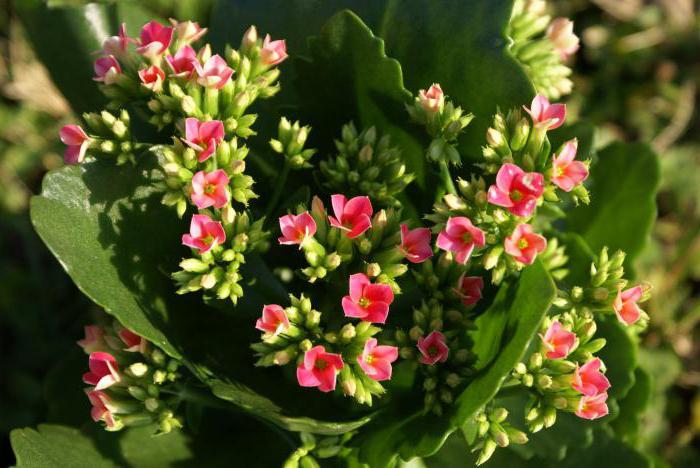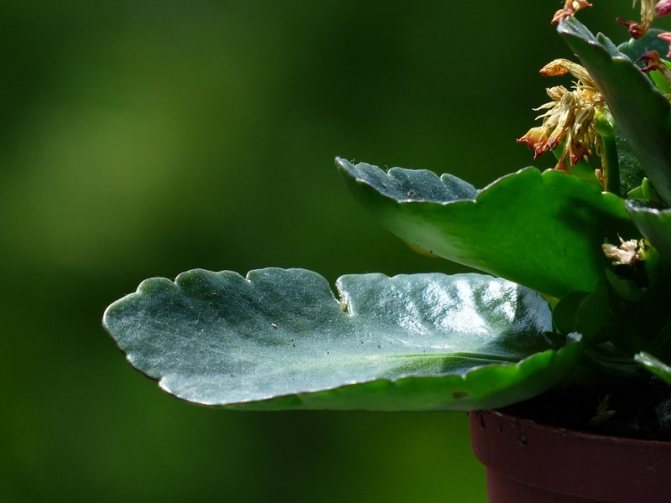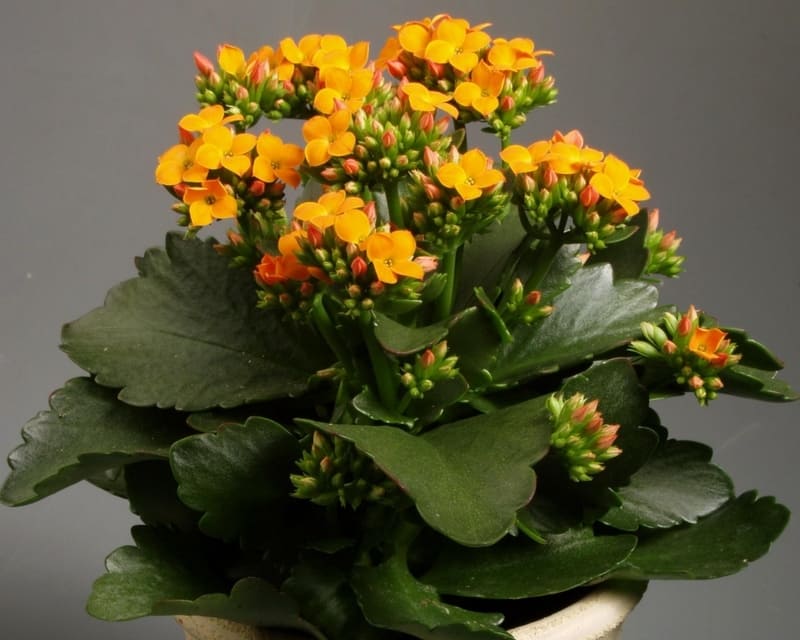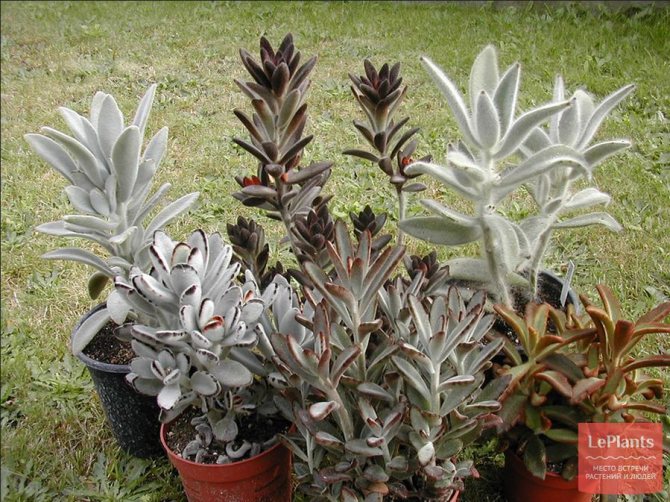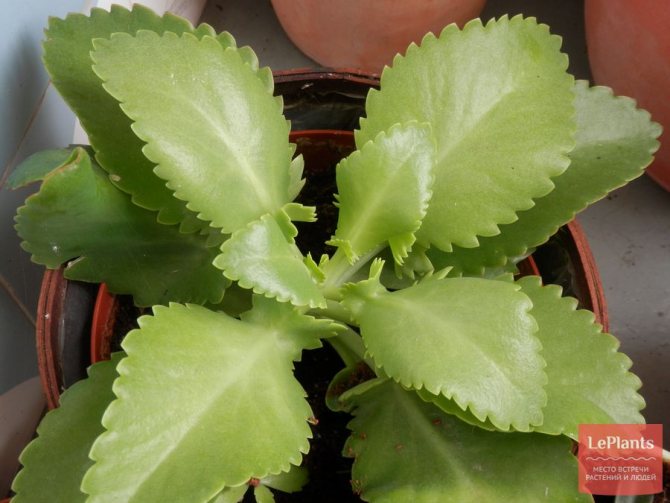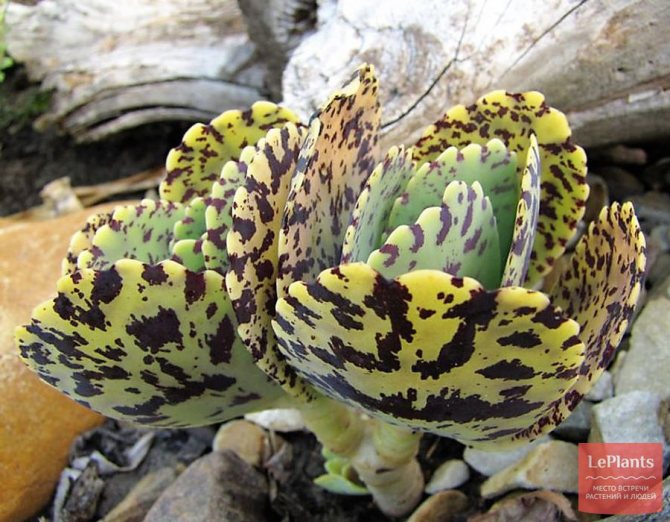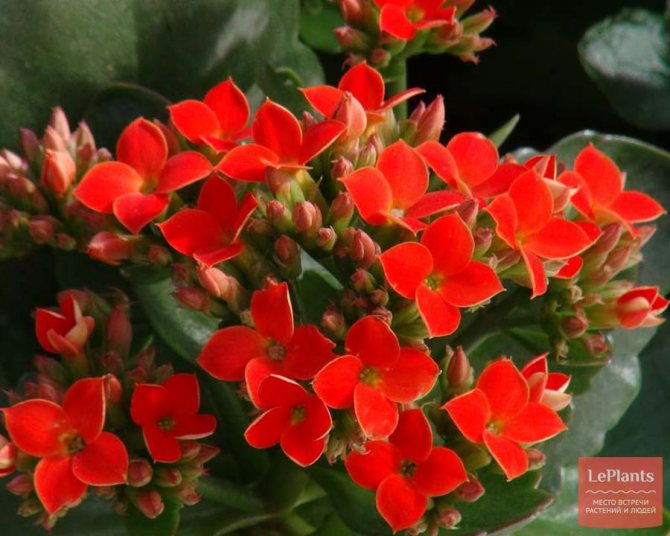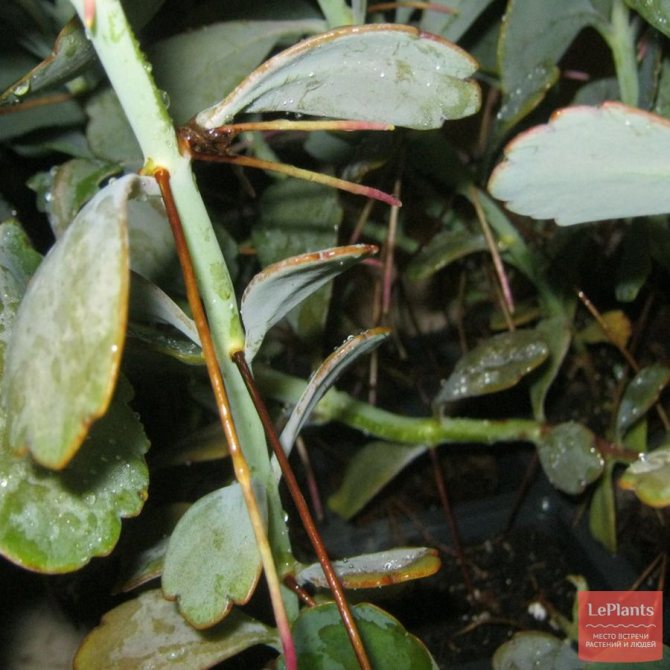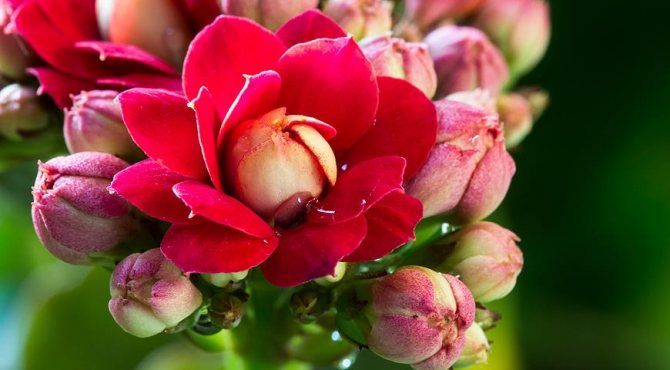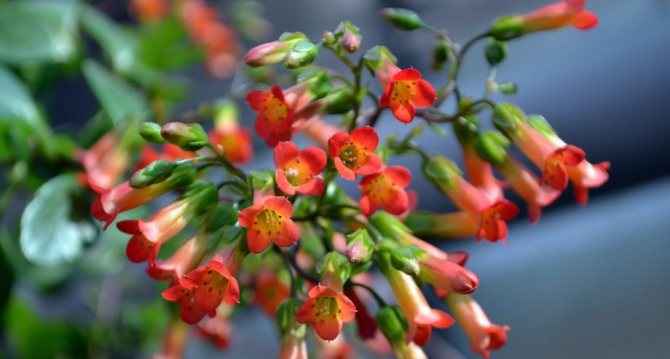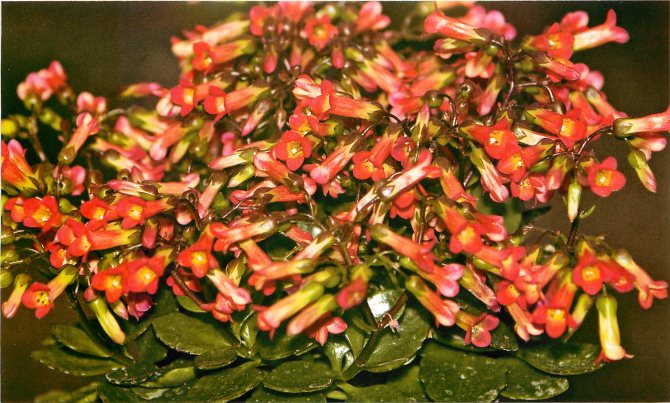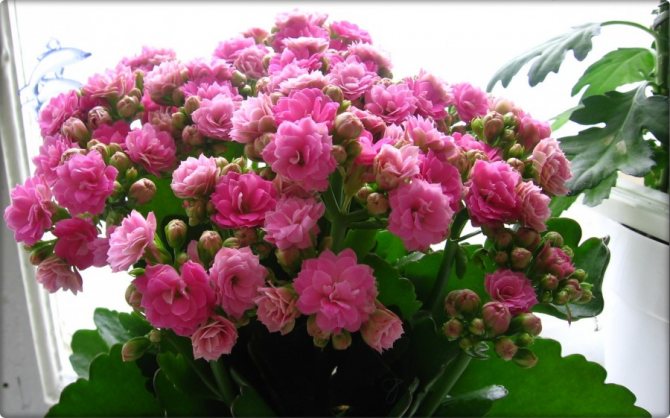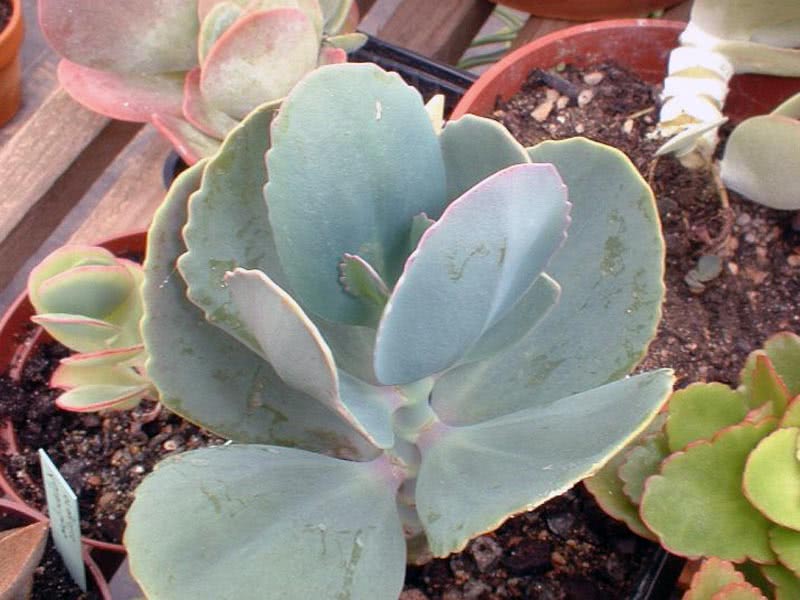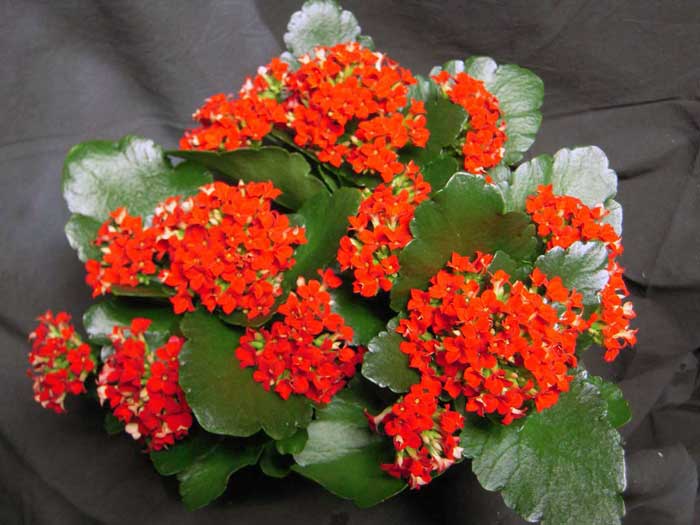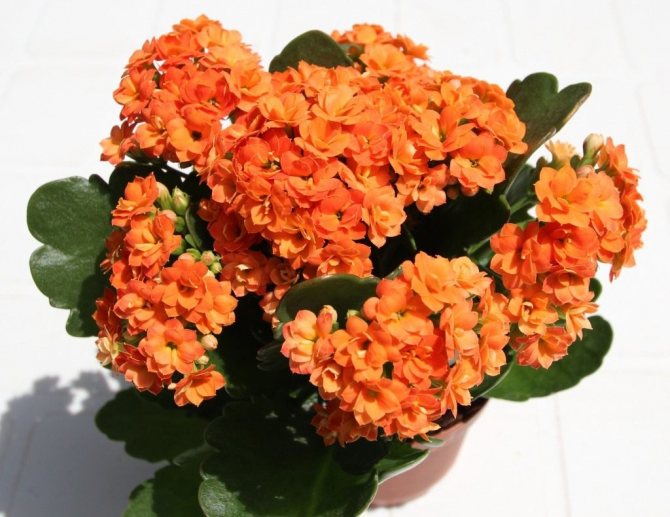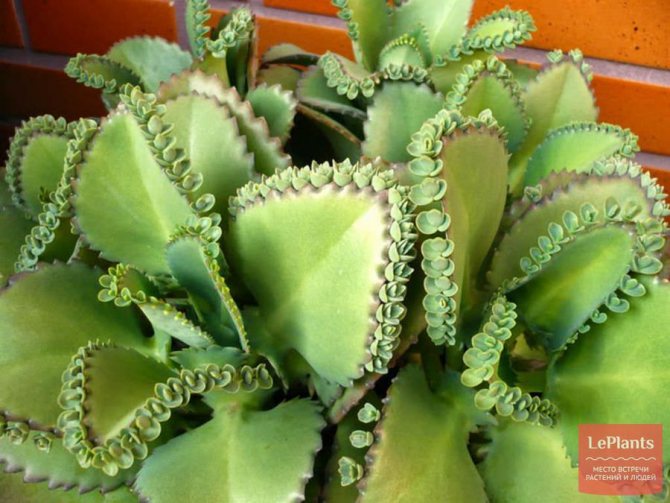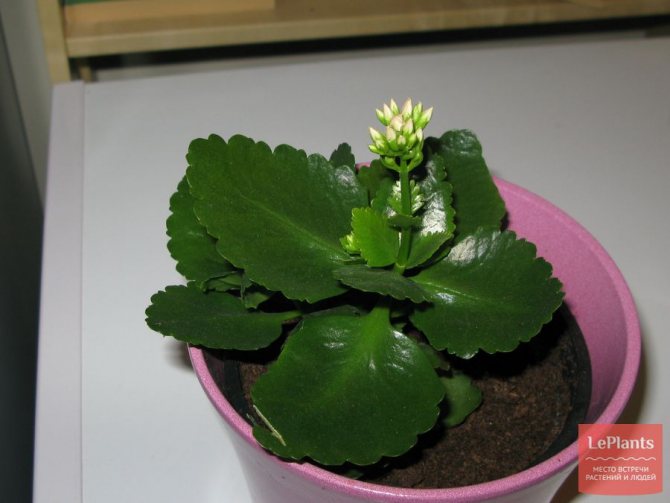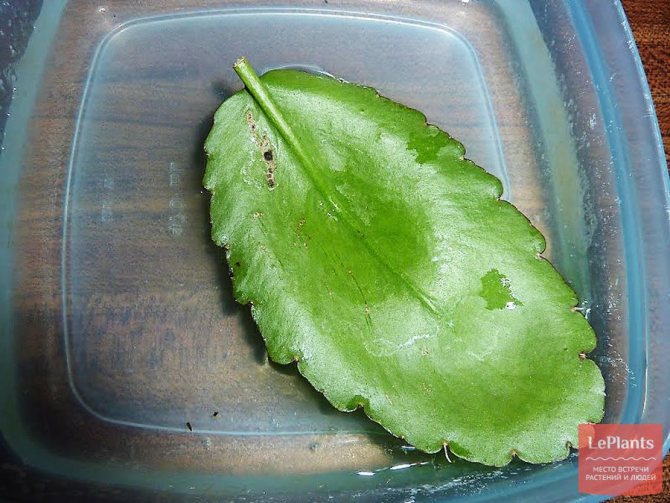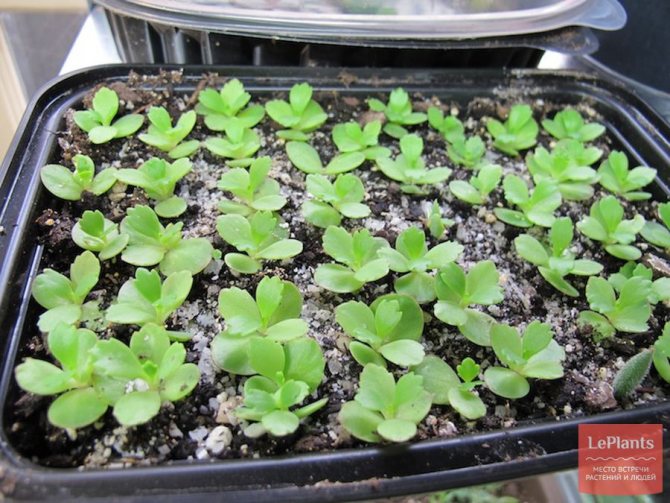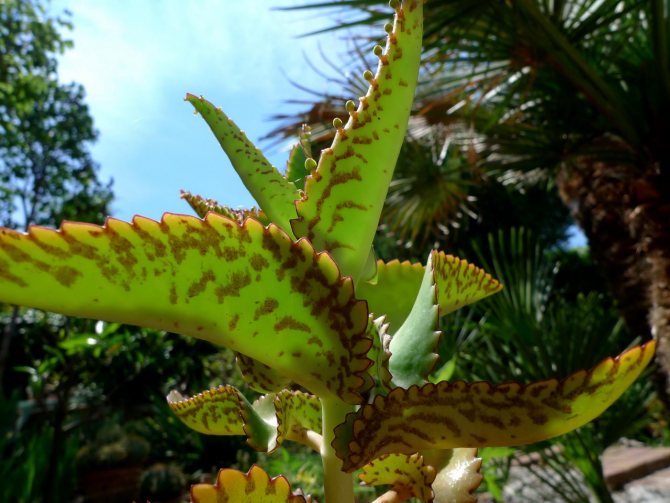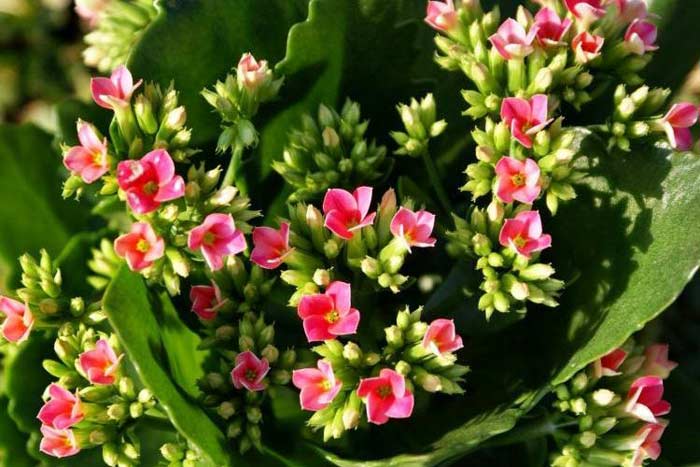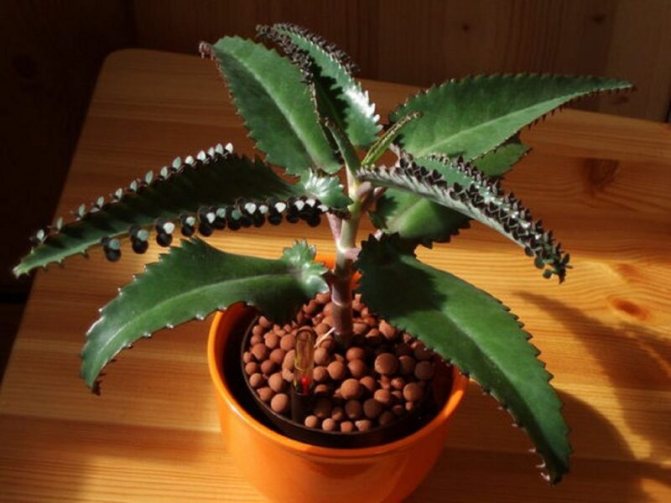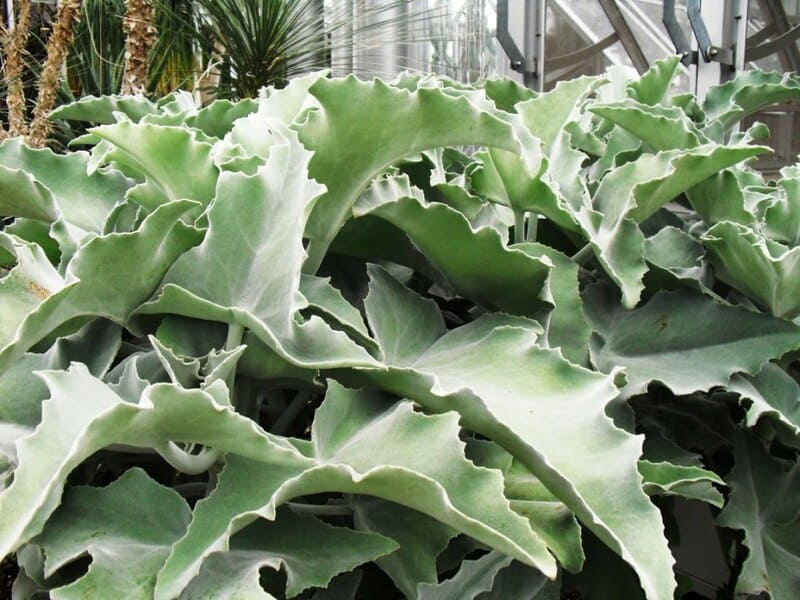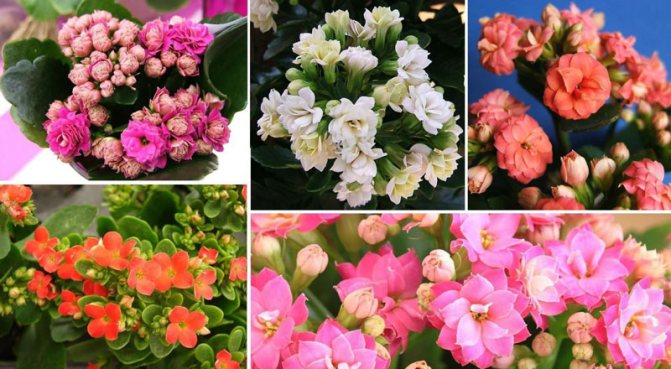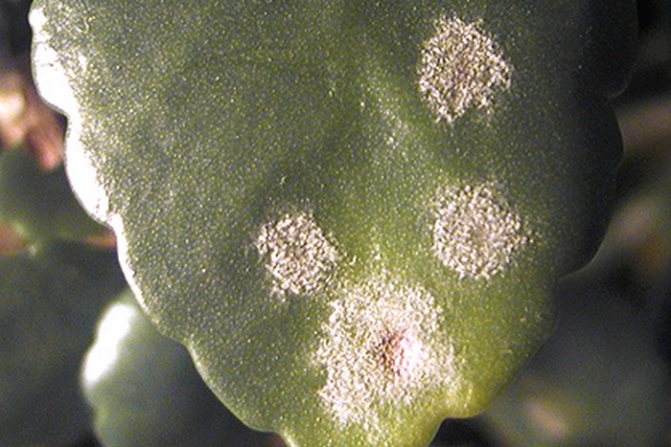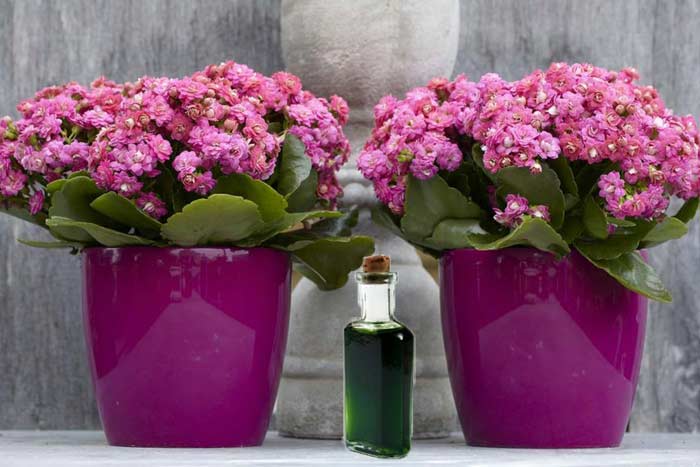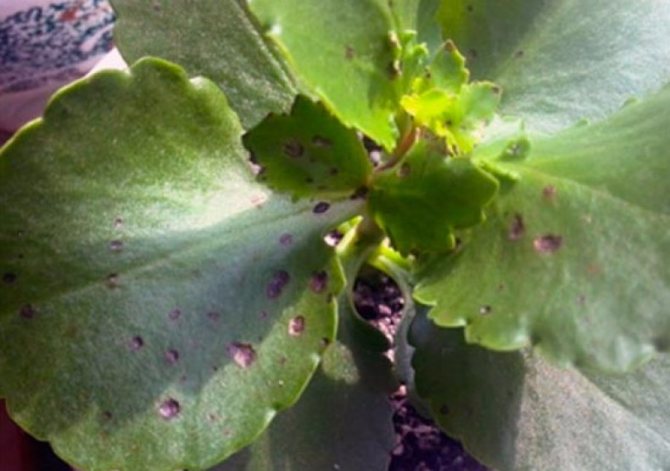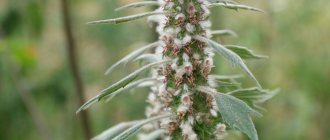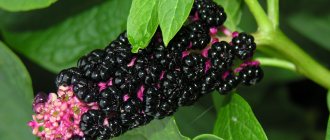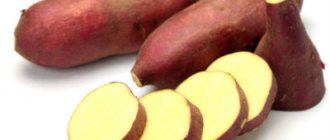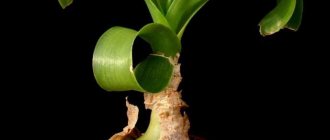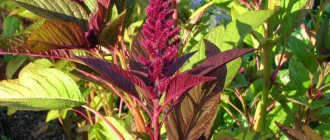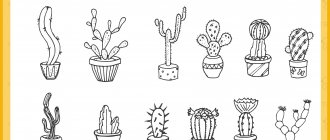I never seriously believed in folk remedies like "aloe juice" and "drops from Kalanchoe", it seemed to me all the Middle Ages, in our century, far-reaching medicine, synthesizing drugs from complex molecular compounds. I did not believe for the time being. Although my mother told me how, when I was one and a half year old, they treated pneumonia with folk remedies, because I have a terrible allergy to antibiotics. I didn’t believe it until the most unpleasant sore happened to me, which was cured by an Indian onion (aka the tailed poultry farmer).
Winter and the season of colds are in full swing. I propose to look at our window sills not only as a green decoration of an apartment, but also as a pharmacy.
Today we are talking about the most popular plant among medicinal plants - Kalanchoe.
There are many varieties of Kalanchoe that adorn our windowsills. In recent years, blooming Kalanchoe with bright colors of various shades, striking in their beauty, have increasingly appeared. Are all equally useful?
Kalanchoe is a genus of succulent plants of the Tolstyankovy family (Crassulaceae
). More than 200 species are known that grow in tropical and South Africa, South and Southeast Asia and in the tropics of South America. The genus name is of Chinese origin. There are about 200 species of Kalanchoe, a distinctive feature of which are fleshy juicy leaves and stems.
Views
Kalanchoe pinnate
Kalanchoe Degremona
It is also called Bryophillum Degremona. The flower reaches a height of up to 50 centimeters, and its leaves up to 20. They are either narrow triangular or narrow ovate. On them, nature has tried so hard, small brood buds are formed, thanks to which natural reproduction can occur. As soon as they fall off on their own, the rooting process begins. Homeland - the island of Madagascar. In Europe, the flower appeared at the beginning of the 20th century.
The difference between the two species described above is the abundant formation of children from the side of the feathery Kalanchoe. Degremon's stalk is very often unable to hold large leaves and needs additional support. But its leaves have a much richer color than that of the pinnate Kalanchoe. The care of these two species is almost identical.
Kalanchoe Blossfeld
This flower is striking in its height. It can rarely reach 45 centimeters. The leaves are large enough, have a rich green color and have a border around the edges. Starting from February, the plant begins to bloom with small red flowers. But his palette of shades does not stop only on red. Thanks to the work done by the breeders, the palette has increased incredibly.
Kalanchoe is one of the favorite and demanded plants. It can be seen in almost every home. Besides that Kalanchoe blooms very beautifully in different shades of colors, it also has medicinal properties
... This is known not only among the people, but also in official medicine. Let's take a closer look at this houseplant, the history of its appearance and its homeland.
The homeland of the plant is the island of Madagascar. It was from this island that the flower began to spread further and now it can be observed in almost every family.Where does this plant grow outdoors?
The homeland of the Kalanchoe houseplant is the warm tropics of South Africa, the island of Madagascar
The plant is distributed in the following places
:
- India;
- Australia;
- Madagascar;
- islands of New Guinea;
- Moluccas;
- tropical islands of America and Asia.
Height in the wild can reach up to one and a half meters. In such an environment, the plant loves rocky soil, steep mountain slopes, and sometimes it can be observed very high - 1250 meters above sea level.
At home, it is much more compact and smaller. This species is widely distributed as an ornamental plant. In climates with low temperatures, the flower does not take root and dies
.
To obtain medicinal raw materials, the plant is cultivated in the subtropics of open ground, in countries such as Georgia and Central Asia.
Kalanchoe - a gift of nature
This perennial evergreen plant grows in tropical regions of Asia, Africa and America, as well as on the island of Madagascar. Under natural conditions, it can have a height of 15 cm to 4 m. A characteristic feature of the Kalanchoe, the varieties of which include more than 200 items, is its belonging to the group of succulents - plants with thick fleshy leaves and capable of accumulating moisture. Due to this, such species can be in drought conditions for a long time.
In Europe and the CIS, Kalanchoe is known as an unpretentious indoor flower that grows on a windowsill. However, not all varieties of this plant take root at home, but only about ten.
According to their characteristics, they can be divided into two types: decorative and medicinal.
Medicinal kind
It is the medicinal plant species that is widely used in folk medicine. In everyday life, it even received the name "tree of life". And this is no coincidence, because Kalanchoe contains in its composition a number of valuable microelements, namely: magnesium, iron, zinc, aluminum, calcium, manganese. In addition, the plant is rich in enzymes and vitamins. Such a combination of useful qualities allows the use of Kalanchoe in such problems:
And this is just a short list of diseases that Kalanchoe effectively cope with.
Types of plants that are used for treatment:
- Cirrus
- this variety of Kalanchoe is found in almost every home. It can be recognized by its characteristic monochromatic fleshy leaves that have the shape of a feather. On the rounded edges of the leaf, you can often see small buds with roots (they are also called "children"), which the plant reproduces with. This indoor flower does not look very pretty, but it has excellent healing qualities. In pharmacies, juice of this particular type of Kalanchoe is sold. - Degremona -
Madagascar representative of Kalanchoe, which has healing properties. It is very similar in appearance to its previous relative, but its leaf is distinguished by bright purple or brown blotches. Degremona also reproduces in children. The variety has a paniculate pink inflorescence with short petals. In the conditions of an apartment, it grows no higher than 50 cm.
For medicinal purposes, the juice of these plants is mainly used, although sometimes the leaves with pulp and the stem itself are used, on the basis of which ointments, creams and tinctures for external use are prepared.
Decorative varieties
Flowering plant species bring no less benefit in the house: they do an excellent job with their decoration function, and also cleanse the energy of the space well.
Kalanchoe is a very common plant, but only a few flower owners know the history of its origin. Knowing where the Kalanchoe appeared on our windowsills and where the homeland of the indoor plant is will help to determine the peculiarities of caring for it and avoid mistakes.Growing a plant in apartments most often carries not only a decorative purpose, Kalanchoe is widely used in folk medicine and is a source of many microelements useful for the body.
The homeland of the plant is the warm tropics of Madagascar. In its natural environment, the Kalanchoe prefers mountainous terrain. There it can reach one and a half meters in height. The plant can also be found in Australia, India, New Guinea, the Moluccas, and the American and Asian tropics.
The first mention of Kalanchoe dates back to the 18th century. Notes about the plant were found in sailors' logs. One sailor contracted tropical fever. The disease was considered incurable, so he was left for dead on a nearby island.
On the way back, the crew of sailors decided to drop by the island to honor the memory of their deceased comrade. There was no limit to the amazement of the sailors when they saw a perfectly healthy sailor. The miraculously cured sailor willingly told the story of his healing. The inhabitants of the island picked him up and treated him with an extraordinary plant called Kalanch. In the local dialect, this word was also used to define the word health.
Thus, thanks to the medicinal properties of Kalanchoe, they learned about it all over the world. The crew of sailors brought the green doctor with them for further distribution.
The legend of the flower, its origin
Starting from the 18th century, the first name of the flower can be found in the notes of ship magazines. The history of the origin of the name begins with the fact that during this period merchants from Russia traded in South Africa. One of the crew of sailors unexpectedly fell ill with a very dangerous disease at that time
... It was tropical fever. The disease was extremely rare, so it was considered practically incurable. In this situation, the team had to leave the sailor on the nearest island.
A few weeks later, returning and sailing past this island, the team visited the patient. They could not believe their eyes, as the dying comrade was in a perfectly healthy state. He recovered thanks to the plant used by the inhabitants of the island. In their dialect, the flower was called "Kalanch", which in translation meant health
... Thus, the Kalanchoe flower got its name thanks to its medicinal properties.
Sadovoe
it medicinal plant grown on plantations on an industrial scale in the southern regions of the country, where it is planted in furrows on loamy and sandy loam soils. The collection of raw materials begins in two to three years, when the young plants have grown enough and filled with juice.
There are species that grow in the south of the country, in places where the temperature does not drop below 5 degrees, in the garden for decorative purposes.
Many flowering varieties are planted in flower beds as annuals and in the central regions of the country, with the first frost the plants die.
Life span
Both outdoors and indoors Kalanchoe lives long.
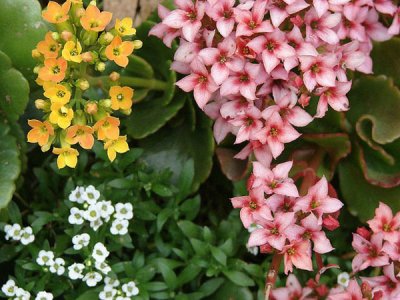
There are cases when Kalanchoe grew in a room for about 20 years, constantly being pruned.
Any kind absorbs radiation from household appliances, purifies the air. The plant has a beneficial effect on the elderly and children, on those who are recovering from a serious illness.
It helps people with a weak character to cope with problems, feeding them with energy. And the strong people are assisted in the disclosure of talents and internal reserves.
Treatment with Kalanchoe (beneficial properties) has been used for a long time.
It helps fight inflammation, fights viruses, stops bleeding, heals burns.
The most common types
Benta
It is a powerful and tall plant. Its height can reach up to one meter, and the leaves are up to fifteen centimeters in length.
... It blooms with inflorescences in the form of white umbrellas.Flowering time begins in the middle or late spring.
More common than the previous one. It is more compact and does not exceed 30 centimeters in height
... Blooms for a long time. The flowers are red. Flowering occurs from late winter to autumn. Modern hybrids are orange, white, pink and yellow in color.
Kalandiva
The flower is a hybrid form of Kalanchoe Blossfeld.
A distinctive feature is abundant and longer flowering.
.
This is a shrub. Its shoots are erect and heavily pubescent. It is thanks to this that the flower got its name. Leaves are ovoid. They do not have petioles, so they attach to the shoots and trunk.
... The flowers are umbellate and small.
Degremona
The herbaceous species reaches a height of up to half a meter. Leaves are not pubescent, gray-green. Leaves are up to 10 centimeters long
... Unusual purple spots may appear on them. Inflorescence panicle. The color of the flowers is pink.
In terms of medicinal properties, it is practically not inferior to ginseng, therefore it is highly demanded.
Another name for the plant is marble. Grows in the form of a shrub. Height about fifty centimeters
... Leaves are usually green, but with constant exposure to direct sunlight, they turn reddish.
Umbrella inflorescence with light yellow flowers. Emits a pleasant aroma when blooming
.
Is a herbaceous perennial plant. The flower reaches one meter in height
... Panicle-shaped inflorescences. The flowers are reddish-green. Like Degremona, it has quite good healing properties.
Indoor flowers Kalanchoe: photo and description
The Kalanchoe home flower is one of the most popular indoor plants. With minimal maintenance, it gives wonderful results.
Kalanchoe
- a plant belonging to the genus succulent of the Tolstyanka family. It grows in South Africa and East Asia, has about two hundred species. Depending on the species, it can be of different heights from a few centimeters to 2-3 meters in height. When describing the Kalanchoe plant, special attention should be paid to the leaves: they are fleshy leaves, can be covered with hairs or absolutely smooth, of various shapes and sizes, with jagged or even edges, on which rooted buds are often found. As these buds mature, new plants are formed.
Look at the photo - the flowers of the home Kalanchoe are large, formed on a high peduncle, can have a color from pale pink to burgundy:
The species of Kalanchoe are quite numerous - there are more than 200 of them in nature. The most common in cultivation are Kalanchoe Degremona, as well as Kalanchoe pinnate. It is these types of Kalanchoe that have healing properties.
In Madagascar Kalanchoe Mangina
spreads along the ground. On its short shoots, a peduncle sometimes appears with drooping bell-shaped flowers. At the ends of other shoots, small daughter plants are formed and thus a whole carpet of Kalanchoe is gradually formed. The cultivar 'Tessa' originated from the wild and has now become a popular plant for bright spaces in living quarters and patios. In summer, you can only admire the foliage, because flowers do not appear until the daylight hours are longer than 12 hours. This “short day” plant does not flower until fall, winter or early spring.
Kalanchoe pinnate
- an evergreen plant with a height of 60 to 120 cm.Despite the fact that the chemical composition of the plant has not yet been fully studied, it is reliably known that it contains a lot of tannins, vitamins P and C, aluminum, copper, iron, manganese and calcium , as well as polysaccharides and organic acids and other organic substances of protein origin, which have a positive effect on human immunity, improving metabolism, and accelerating biochemical processes in the human body.
Here you can see a photo of the Kalanchoe, the description of the species of which is given above:
The appearance of a houseplant
Plant of the Tolstyankov family. Like all species of this family, the flower is distinguished by a wide variety of varieties and hybrids
... The appearance is very diverse and can be from woody to ampelous forms.
Since the plant is a succulent, the leaves are quite thick and succulent. The petioles on the leaves are very short, therefore they are also called sessile. The form is very diverse. There is an oblong, rounded, triangular shape, as well as with wavy, even or finely toothed edges. Coloring ranges from reddish to green. In some species, the leaves can be pubescent, covered with waxy blooms, and also speckled.
The diameter of the flowers is small, about one centimeter. More often collected in inflorescences in the form of an umbrella, less often in the form of a panicle.
Depending on the type height varies from 15 centimeters to one and a half meters
.
Kalanchoe - views and photos:
Kalanchoe Blossfeldiana - photo and description
Kalanchoe Blossfeldiana Kalanchoe Blossfeldiana Kalanchoe Blossfeldiana Kalanchoe Blossfeldiana Kalanchoe Blossfeldiana Kalanchoe Blossfeldiana Kalanchoe Blossfeldiana
Plant height 30-45 cm, leaves are rounded, wavy along the edge, red flowers, collected in semi-umbellate inflorescences. Mainly they grow hybrid varieties with white, yellow, orange, purple, pink, red flowers: Bali, Singapore, Calypso, Fortyniner, Beta, Santorini, Coral Mirjam, Alexandra and others. There are also miniature forms, up to 15 cm high, with bright red flowers.
Kalanchoe Beharskoe (Kalanchoe Beharensis) - photo and description
Kalanchoe Bekharskiy Kalanchoe Bekharskiy Kalanchoe Bekharskiy Kalanchoe Bekharskiy Kalanchoe Bekharskiy Kalanchoe Bekharskiy
Weakly branching plant up to 20 cm high, leaves are large, triangular, with a wavy edge, covered with a grayish wax-like bloom. The flowers are small, yellow. The variety Aureo-aeneus is widespread with leaves covered with reddish-brown hairs.
There are tree-like representatives.
Kalanchoe Manginii (Kalanchoe Manginii) - photo and description
Kalanchoe Manginii Kalanchoe Manginii Kalanchoe Manginii Kalanchoe Manginii Kalanchoe Manginii Kalanchoe Manginii Kalanchoe Manginii Kalanchoe Manginii
Stems are thin, about 30 cm long, hanging with age. Leaves are dark green, juicy, oval, smooth edge, slightly wavy at the top. The flowers are red, brood buds are formed in the inflorescence. There are hybrid varieties with a variety of flower colors: Tessa, Wendy, Mariko, Jingle Bells, Dream Bells, Mirabella. It is recommended to spray the plants, since the duration of flowering depends on the humidity of the air.
Kalanchoe Freckled (Kalanchoe Marmorata, Grandiflora) - photo and description
Kalanchoe speckled Kalanchoe speckled Kalanchoe speckled Kalanchoe speckled Kalanchoe speckled Kalanchoe speckled Kalanchoe speckled
Semi-shrubs up to 50 cm high, leaves obovate, 8-12 cm long, notched-toothed along the edges, green, later grayish on both sides, in large brown spots. The flowers are white, 6 cm long. Synonym - Kalanchoe grandiflora.
Unique properties of the flower
Almost everyone knows about the healing properties of Kalanchoe. Previously, the flower was used only at home, but now it is recognized by official medicine.
Kalanchoe is used for
:
- stop bleeding
; - healing cuts
, wounds; - treatment skin diseases
; - treatment colds
and flu; - removing inflammatory processes
; - toothache
and etc.
In medicine, the juice of the plant is used exclusively for external use, and when treating with the folk method, the juice is taken internally.
Useful properties of Kalanchoe and use in traditional medicine
Kalanchoe has a lot of useful properties. In particular, the plant has the following medicinal effects:
- wound healing;
- anti-inflammatory;
- hemostatic;
- antiseptic;
- tonic;
- regenerative;
- cleansing;
- immunostimulating.
Traditional medicine uses indoor flower to treat the following diseases:
- Pressure sores, ulcers, wounds that are difficult to heal.
- Ulcers, boils.
- Skin rash.
- Burns.
- Eczema.
- Consequences of insect bites.
- Chronic fatigue.
- Diseases of the gastrointestinal tract, including ulcers.
- Violation of the kidneys.
- Cervical erosion.
The plant is especially popular among people with colds and runny nose. Previously, the popular cure for the common cold was the drug Naphtizin, which is contraindicated in young children. Mothers got along with Kalanchoe juice, so now many people associate this flower with sneezing and childhood.
Traditional medicine also recognizes the medicinal properties of this plant, but, unlike traditional medicine, it uses the components of the plant for external use only.
Folk recipes
For the correct use of Kalanchoe, you need to know its properties. therefore people created special folk recipes
which always bring positive and pleasant results.
Various infusions, ointments, decoctions are made from the flower.
Juicing
To get Kalanchoe juice, it is recommended to choose the most juicy, large and not damaged leaves.
For this purpose, it is necessary to cut off well-ripened shoots with fleshy leaves. The plant needs to be washed well and dried. In order for the plant to give as much juice as possible, it must be pre-cooled
... To obtain juice, use a meat grinder or blender. After that, the resulting juice is squeezed through a cloth napkin and stored in a refrigerator in a glass or porcelain container.
Alcohol tincture
To obtain the desired tincture, you must use the pulp of the flower. The plant is crushed into pieces and poured with vodka or alcohol
.
Proportions
:
- four tablespoons pulp
- two hundred grams of vodka
or one hundred grams of pharmacy alcohol
The main cooking condition is extract of the tincture for 21 days
... The place should be cool and dark.
Ointment
When preparing the ointment, fat is used.
... It can be chicken, badger, dog, mutton, or baked milk fat.
I use a water bath for cooking. Take equal parts of crushed leaves and any of the above types of fat. The temperature in the water bath does not exceed 60 degrees Celsius
... At this temperature, the workpiece will be cooked within one hour. Then it must be left to cool for 24 hours. This process should be repeated for at least two days. After that, the finished consistency is placed in a cloth and squeezed out.
This preparation option will allow you to store the ointment for a long time and it is better to do this in the refrigerator.
Currently a flower is no longer only beloved, but also in demand
... Its compact shape, long and bright flowering, as well as numerous beneficial properties have made it one of the most common among the world's population.
January 22, 2016
Very often on the windowsills, among a variety of indoor flowers, you can find Kalanchoe. The homeland of this plant is Madagascar and South Africa. Kalanchoe is distinguished not only by its beautiful appearance, but also by its extraordinary healing properties.
What do the signs concerning the Kalanchoe say?
- A plant that has a healing effect on a person can in no way harm him.
- Kalanchoe is not only an assistant in household affairs, but also a protector of his health.
- Kalanchoe, which is grown at home, restores the strength lost by residents during the day. The plant returns vitality. That is why it is advised to have it in those houses where people are forced to live with energy vampires.
- If the Kalanchoe "settled" in the house, then after a short period of time, the people who live here will stop arguing and swearing with each other. Understanding and peace will come in the family. Mutual misunderstanding, hostility will disappear as if by magic.
- Kalanchoe is able to absorb the negative that reigns in the room.
- If the Kalanchoe suddenly died, it means that the family was damaged, which was taken by the flower. You need to try to plant a new plant as quickly as possible.
- Kalanchoe needs to be grown in the kitchen, preferably on the windowsill. The whole family constantly gathers here and from this place it is easier for the plant to take care of the family hearth.
- Flowering Kalanchoe means peace and harmony in this family. If for many years the plant has not given flowers, then your whole family and friendly relations are just fiction.
- Kalanchoe is able to work miracles, stuffing the head of bad people with good thoughts, directing them to do good deeds.
Many novice growers, knowing about the healing properties of the clanchoe flower, buy a plant they like and try to use its juice for medicinal purposes, and then wonder why no results are visible. The thing is that only two types of Kalanchoe indoor flowers are used for medicinal purposes - Degreion and pinnate. You will learn about the usefulness of the Kalanchoe flower and how to grow it in this material.
History of the name
One of the ancient legends explains the appearance of the Kalanchoe in different countries of the world. For the first time this name was mentioned in a ship's log entry made in the 18th century. Russian merchants who traded in Africa were confronted with an amazing case of the cure of one of the sailors. He contracted a very dangerous and rare disease - tropical fever, so it was decided to leave him on the South African island to save the rest of the team from imminent death.
Coming back a month later, the ship again moored to this island and the sailors were surprised to find their comrade quite healthy. It turned out that the locals were able to cure him of a deadly disease with the help of the leaves of a plant they called Kalanch (health). Today, many housewives grow Kalanchoe houses, whose homeland is southern Africa.
Diseases and pests
Kalanchoe can get sick in the presence of various factors. The most popular plant diseases are described below:
- Aphid
- this is the most serious disease for a plant. Determining this disease will not be difficult. Small greenish insects begin to spread over the entire flower. If aphids appear, the plant stops receiving useful compounds, the leaves turn yellow, if there are flowers, then they begin to fall off. Even the death of the Kalanchoe flower is possible from this disease.
What to do?
If the aphid has spread strongly throughout the plant, then the affected areas of the flower should be cut off, the remains should be washed with laundry soap. However, if a small part of the plant is affected by aphids, you just need to rinse the flower with soapy water. Such liquid should not get into the ground of the flower.
Aphid
- Shields -
it is a grayish bloom from small insects. As a result, a sharp wilting of the Kalanchoe occurs, the fungus spreads, the plant stops blooming.
What to do
: When removing scabbards, you must use an alcohol solution because of the mucus secreted by them. After treating the plant with alcohol, carefully remove the insects with a cloth, without injuring the plant. After the manipulations done, the flower will recover by itself.
Shields
- Dark spots on the trunk and leaves -
signs of rotting soil and roots. What to do: Observe the watering regime. In the summer - about 1-2 times a week (but do not forget to check the soil to see if the top layer is dry). In winter, water should be done once every 10 days. If the ground is covered with mold or has a rotten smell, it is better to transplant such a plant into a new substrate by washing the roots in a solution of potassium permanganate.
Rot spots
- White bloom on the leaves -
spraying with hard water.
What to do
: stop spraying (this plant does not need it). Wipe the leaves with boiled or filtered water.
Spraying with hard water
- Leaves turn yellow, dry, curl up and fall off—
often drying and falling of the lower leaves is the life cycle that forms the tree-like stem of the plant, but it can also be caused by drying out of the soil or very dry hot air in the room (plant next to the heating battery).
What to do:
Observe the watering regime, remove from a strong source of heat.
If the yellowed leaves are visible only from above, your plant suffers from a lack of light (should be rearranged in a bright place, avoiding direct sunlight). If the leaves turn yellow along their entire length and curl, perhaps there was too much bright sunlight, in this case it is better to place the plant in a shaded place.
If the tips of the leaves dry, you need to pay attention to the size of the pot, it may be too small and the plant needs replanting. Leaves are curling up - examine the plant for aphids (read about aphid control above).
- The leaves have become soft
- most likely the plant was standing in a hot place, in the open sun, or in a room with dry hot air.
What to do:
remove the plant from the heat source, water if the topsoil is dry. in the future, observe the watering regime, and put it in a shaded place with a temperature of 18 - 25 degrees.
Care features
When growing such exotic flowers at home, it should be remembered that the birthplace of the Kalanchoe (a houseplant brought to us from the tropics) is a completely different climatic conditions. Therefore, appropriate care is required for his comfort. Nevertheless, this plant quickly adapts to existing conditions and belongs to the category of the most unpretentious. Like most southern plants, Kalanchoe calmly tolerates a lack of moisture, but needs warmth and sufficient lighting.
Photo
What does it look like? Flower:


Doctor:
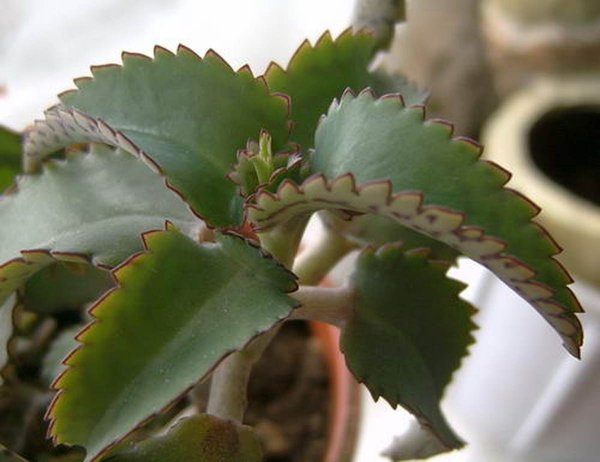

Room:


Home:
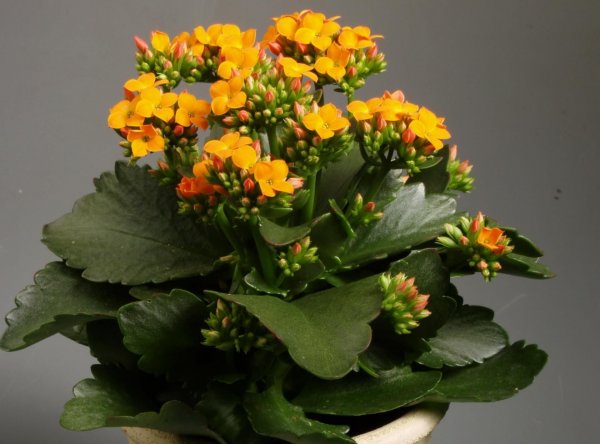

Sadovoe:
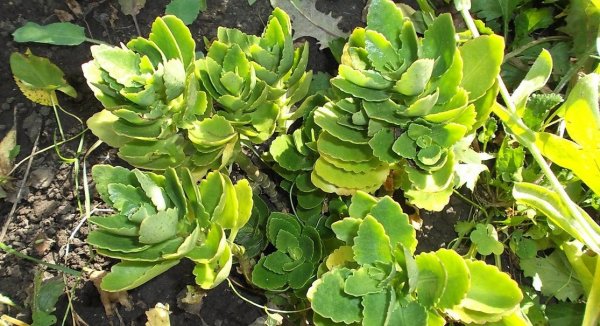

In a pot:
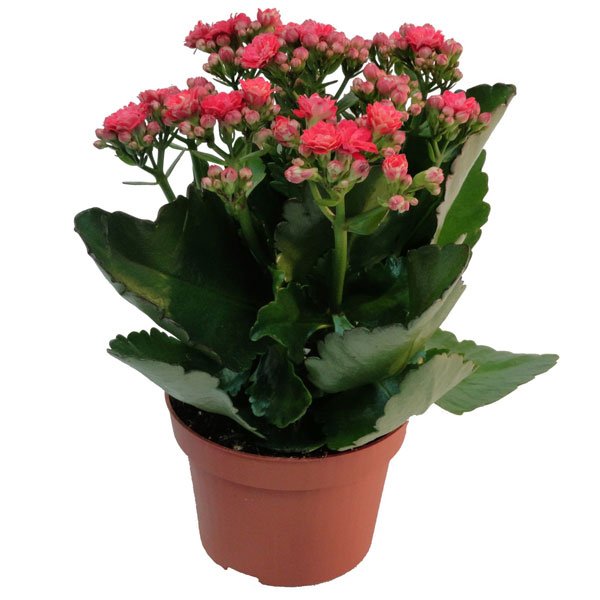

Streetwear:
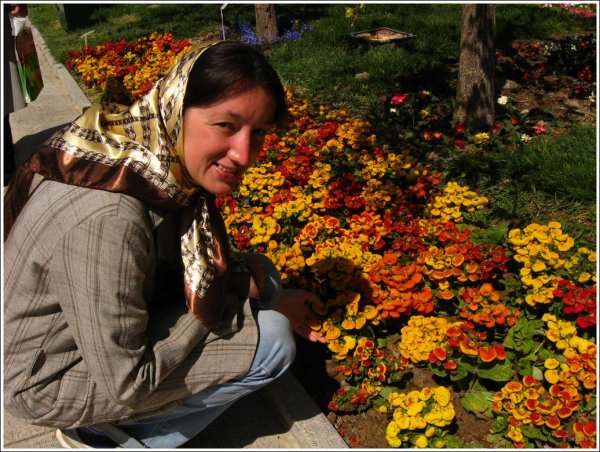

Optimal soil composition for Kalanchoe
Today, a wide variety of potting soil mixes are available at the store. The composition intended for cacti and succulents is quite suitable for Kalanchoe, whose homeland is in the tropics. It is only necessary to add one sixth of the rotted compost to it. It is quite possible to use universal soil for planting, mixing it by about one third with fine expanded clay.
If desired, the soil mixture is prepared independently, there is nothing complicated about it. You need to take sod and leafy soil (in a ratio of 4: 2) and one part of sand and peat. A little humus or dry manure is added to them.
How to propagate and transplant a flower at home
The plant is propagated in three ways: by cuttings; by the seminal route and by children. It is quite easy to get a new flower from a cutting. To do this, a leaf with a shank is cut off from the mother bush and placed in fertile soil for rooting.
To speed up the rooting process, cover the cutting with a transparent cap. A glass jar or cut-off plastic bottle will work for this. It is better not to water the soil under the handle, but to spray it. The rooted and matured stalk is transplanted into a separate pot as an adult plant.
Reproduction of a flower by seed involves the following actions:
- The container is filled with soil enriched with peat.
- Seeds are sown on moist soil without burying. To prevent the seed from washing out, you can lightly trample them with your fingers or press down with a ruler.
- The container is covered with glass and shaded with paper. It is placed in a room with a temperature of 16 ℃ to 20 ℃. Seed care involves daily spraying and airing.
- Glass and paper are removed when sprouts appear.
- 3-4 weeks after sowing, the sprouts dive into a larger container.
- When 3-4 leaves appear on a young Kalanchoe, it is transplanted into a separate pot as an adult plant.
On some types of flowers, babies are formed. As a rule, they have their own air roots.The babies are carefully separated from the mother bush and planted in separate pots. Caring for children is similar to caring for an adult Kalanchoe.
Young Kalanchoe are transplanted annually. It is permissible for an adult plant to change the soil every 2-3 years. It is recommended to replant the flower in the spring. Transplanting a flowering Kalanchoe is unacceptable.
The flower is well suited for succulent soil. You can prepare the soil yourself. This will require the following components:
- sod land (1/2);
- leafy ground (1/4);
- sand (1/8);
- peat or needles (1/8).
The plant has a very developed root system, so the pot must be roomy. Kalanchoe is watered from below, so the flowerpot should be selected with a removable tray and drainage holes.
Temperature and lighting
Since the homeland of the Kalanchoe (an indoor plant that settled on our windowsills) is South Africa with its tropical and subtropical climate, the plant is not at all afraid of the sun's rays. In order for it to fully develop, you need good lighting. If a slight shading of the Kalanchoe cannot damage, then a lack of light will lead to deformation and loss of decorative qualities.
The air temperature must be kept high enough - about 22 ⁰С. Drying and falling of the leaves is an indication that the room is too hot. But in winter, the plant feels better at a temperature of 15 ⁰С. If the thermometer is 10 ° C and below, the flower may die.
Watering
Kalanchoe (the homeland of the plant is distinguished by a dry climate) is able to accumulate water, therefore it tolerates drought quite calmly. Much worse for this plant is excessive moisture, which can lead to rotting of the roots and damage to the leaves.


Kalanchoe is watered as the soil dries up, as a rule, twice a week in summer and very rarely in winter. Spraying the leaves is carried out only when necessary, when it is necessary to clean them of dust.
Kalanchoe species
There are more than 200 different types of Kalanchoe. All of them still grow in tropical countries. Some of them are so different from each other that it is difficult to believe in their relationship. The only thing that all these Kalanchoe plants have in common is their homeland.
The Kalanchoe TOMENTOSA (or felt Kalanchoe), which came to us from Central Madagascar, has leaves rounded at the base, the surface of which is covered with thick fluff. Because of this, their color seems to be silvery.
The Kalanchoe Degremona is considered a very common species. This plant with succulent leaves, the edges of which are slightly wrapped inward, belongs to viviparous. New rosettes are formed directly on the teeth of the leaves and immediately take root, gradually breaking off and falling off. This species is known for its amazing medicinal properties.
The decorative appearance of the BLOSSFELDIANA Kalanchoe is distinguished by small leathery leaves, which acquire a reddish tint in the sunlight. Many commercial farms grow flowering specimens of this Kalanchoe all year round. The birthplace of the flower is the central part of Madagascar.
The Kalanchoe TUBIFLORA has a thick and juicy stem. Daughter rosettes are formed in large groups on gray-green fleshy leaves.
Kalanchoe MANGANII has erect thin stems, slightly curved towards the end. They have leaves up to 2.5 cm long. The duration of flowering is affected by air humidity, so this plant needs to be sprayed.
Where the Kalanchoe is home to, under natural conditions this plant can grow up to one and a half meters in height. Nevertheless, it has been successfully grown for a very long time in indoor conditions and is highly valued for its decorative and healing qualities.
Houseplant kalanchoe
(calanchoe) is decorative in all its appearance - it blooms beautifully and for a long time, and the original fleshy leaves seem to be poured out of wax.Plants from the Kalanchoe genus are easy to distinguish from other members of the bastard family by their bright flowers. The genus unites about 200 species of plants, which are very diverse from ampelous to woody forms. These plants grow naturally in the tropics of South Africa, South Asia and South America. The homeland of most Kalanchoe species adapted for indoor cultivation is the island of Madagascar, where these plants usually bloom in January.
Kalanchoe are succulent plants, their leaves, depending on the species, are wide and fleshy or cylindrical in shape, accumulate moisture and nutrients, and with a lack of moisture during a dry period, old leaves die off, giving the accumulated reserves to new leaves.
Interesting viviparous species: Kalanchoe Degremona
(C. Daigremontianum) with fleshy triangular leaves with a serrated edge and
Kalanchoe tubule
(C. Tubiflorum) with elongated tubular leaves, at the ends of which suckers are formed. On the edges of the leaves of these species there are buds, from which young plants with small roots emerge and grow quickly, so these plants multiply easily.
Very original kalanchoe felt
(C. Tomentosa) - its thick leaves are covered with a silvery bloom and brown spots along the edge. This plant is easily propagated by leaf and stem cuttings.
One of the most popular indoor plants is Kalanchoe Blossfeld
(C. Blossfeldiana), has a bright and long flowering from February with a duration of about two months. Nowadays, many hybrids have been created with different colors of flowers - red, pink, white, orange, yellow tones. The flowers are collected in inflorescence shields.
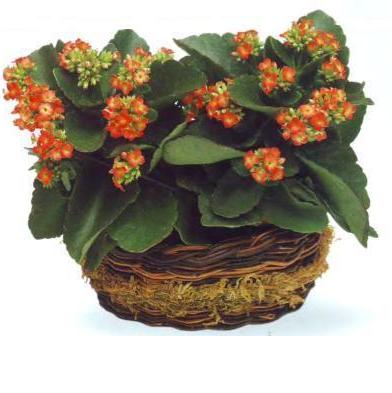

Kalanchoe pinnate
(C. pinnata) is known to many as a valuable medicinal plant, which is widely used in folk medicine. The sap of the plant has anti-inflammatory, wound healing, hemostatic, bactericidal, antiviral effects. To obtain juice, the ground part of the plant is used, filtered, mixed with alcohol for storage, or used to prepare an ointment, mixing with anhydrous lanolin and petroleum jelly. Fresh juice is instilled into the nose for a runny nose and flu, in the ear for neuritis of the auditory nerve, used for rinsing the mouth for stomatitis, periodontal disease, for gynecological diseases and stomach ulcers.


Grow Kalanchoe
on your windowsill is not difficult. This plant is not whimsical, adapts well to indoor conditions, is compact and blooms for quite a long time. It is better to place Kalanchoe in a place where there is a lot of light, closer to the window; southeast or southwest windows are better suited for this. The plant is thermophilic, in summer the optimum temperature for growth is + 20 ... + 25 0 С, in winter it is not lower than +10 0 С.
Like other succulent plants, Kalanchoe should not be watered too abundantly, 1-2 times a week is enough. In winter, water is even more moderate, only after the soil dries out in the pot. Watering should be soft. In the summer, the plant is fed once every two weeks with fertilizers for cactus or succulent plants.
Kalanchoe is transplanted in the spring, immediately after flowering. It is not demanding to the soil, use soil for cactus or succulent plants for transplanting, or make a mixture of equal parts of sod, leafy soil, humus, peat and sand.
Kalanchoe grows rapidly, therefore, in bushy forms, shoots are cut off by 2/3 in spring. The cut pieces can be used as propagation cuttings. Kalanchoe takes root easily, it is enough to lightly dry the cut shoot and plant it in the soil, which is kept moderately moist.
The plant tolerates dry air well and does not require spraying, however, the room where the plant is located should be regularly ventilated.
Often, having bought a flowering plant, home growers wonder why it does not bloom next year.The secret is that flower buds are formed only with a short day of light lasting 9-10 hours. In the middle lane, such conditions are created in September-March, but by this time your plant should rest and form many new shoots. Cutting withered flowers promotes the emergence of new peduncles and prolonged flowering.
Kalanchoe is a houseplant, which is known not only for its beauty, but also for its medicinal properties, belongs to the genus of succulent plants, the family of the fat plant. Currently, there are about 200 varieties of this flower. In nature, it is found in Africa, Australia, Asia, New Guinea and other subtropical regions of the Earth. Moreover, the wild Kalanchoe can be a shrub, succulent plant or herbaceous perennial.
The name of the plant translates as "health", which indicates the presence.
In addition, it looks luxurious: juicy leaves, impressive growth, bright flowering.
How to quickly cure a runny nose?
Wiping the nose inside with Kalanchoe juice helps well, it is advisable to use only freshly prepared juice.
You can inject into the nose 3-5 drops of Kalanchoe juice several times during the day.
Or take Kalanchoe and aloe juice (1: 1), shake it well and instill it in your nose 3 times a day.
Kalanchoe juice for the treatment of a cold can also be mixed with onion juice. To do this, grate the onion and squeeze the juice through cheesecloth. Mix 1 part onion juice and 2 parts Kalanchoe juice. Bury the resulting mixture in the nose 3 times a day.
For the treatment of rhinitis in very young children, Kalanchoe decoction is effective. It is milder than juice.
The origin of the plant
The homeland of the flower is the sunny island of Madagascar. This is a perennial plant that is part of the bastard family. An incredible legend is associated with the origin of the Kalanchoe, which explains its distribution throughout the world. Once in one of the magazines, the subject of which was ships and long voyages, an article appeared about a Russian sailor. During the cruise, he contracted a tropical disease and the team decided to leave him on one of the South African islands to prevent a massive illness of the entire team. After a while, the ship appeared in the same places and, surprisingly to everyone, the sick sailor boarded, while he was quite healthy.
According to the Russian navigator, a medicinal plant that grew on a tropical island helped him to heal. The sailor brought a miraculous flower with him, claiming that the disease had receded due to the fact that he regularly chewed its leaves. In the language of the aboriginal people of the sunny island, the name of the flower meant “health”.
Reproduction
In reproduction, the Kalanchoe, as in many other things, is an unpretentious plant. Reproduction by the leaf of this plant is the simplest.
Parts of the plant for propagation include: babies, seeds, cuttings:
- Scion
Homemade ginseng is grown in wet sand, covered with a transparent jar on top, in the spring season. Or put in water for germination, and then planted in soil. - Seeds
flowers are recommended to be placed in a flower pot under glass with any opaque material so that they are kept in the dark. A couple of times a day you need to ventilate the pot and pour in a small amount of water. The ground should not be dry. ... - After a month, the plant must be planted in a larger pot and covered with foil for two days. Once the leaves begin to appear, transfer to a full-fledged flower pot suitable for succulents. During the period of active growth, fertilizing can be carried out in small quantities. Do not forget about pinching in order for the flower to form large and beautiful.
- Children can simply be put on the ground, they are perfectly accepted.
Description of the plant
Kalanchoe is grown at home most often because of the healing properties of the plant.
However, it is also distinguished by its luxurious appearance, succulent leaves, bright flowers and a unique ability to grow very quickly. During the flowering Kalanchoe, you can admire the gorgeous flowers. They are collected in "panicles" inflorescences, which come in a variety of shades: pink, white, orange, scarlet. With proper care, the plant pleases the owners with its flowering for a long time.
An adult flower can be of different heights. There are low bushes up to 25 cm and one and a half meter trees with a thick stem. The unpretentiousness of the plant is a big advantage. Kalanchoe at home adapts well and grows. Gorgeous flowers can be seen quite often, under proper conditions. Kalanchoe propagates very easily, as a rule, by cuttings and grows very quickly. Currently, there are a large number of hybrid plant varieties with large bright flowers that thrive even in darkened rooms.
Homemade


Indoor flowering plant grown for a long time. Many types of plants are suitable for this. The most common are the Kalanchoe Blossfeld and Degremona.
With proper care, Kalanchoe blooms all year round. Home care is not difficult, the main thing is to always keep the earthen lump slightly moist, prevent the temperature from dropping below 10 degrees, feed it with fertilizer for flowering plants in a timely manner, and remove faded flower stalks. In addition, the plant reproduces easily in all possible ways.
Most popular types
- the most common of the flowering species. An adult plant reaches a height of 45 cm, there is also a dwarf hybrid. The leaves of this Kalanchoe species are smooth, ovoid, slightly wavy at the edges, of a dark green hue. Flowers come in different colors: red, yellow, pink or orange. They are small, up to 1-1.5 cm in diameter. This species received its name in China, due to its high ability to reproduce with the help of cuttings. This variety pleases gardeners with flowering from February to May. Outwardly, it is a low-branchy plant with a straight stem.
Kalanchoe Manzini
- a hybrid bred by breeders from the previous species. Its main difference is its large drooping flowers, bell-shaped. This compact crop looks great in hanging flower arrangements grown ampelno.
- This is a type of kalanchoe, which differs from others in its elegance and diminutiveness. Quite often found in the homes of florists. An adult Kalanchoe plant of this variety reaches a height of no more than 30 cm. Flowers of this species can be of a wide variety of shades, bright terry inflorescences in the form of umbrellas look very impressive, covering the bush with lush caps.
Feathery Kalanchoe (Kalanchóe pinnáta)
Is another popular species cultivated by many growers. His homeland is sunny Madagascar, where the plant reaches 100 cm in height, growing mainly in rocky soils. The lower leaves of the bush have an oblong shape, light green color and a contrasting border along the edge of a reddish hue. The upper leaves have up to five lobes and a feathery structure. Kalanchoe blooms at home irregularly, but for a long time. Most often, the color is collected in late winter or early spring. Flowers drooping, large, have a brick-red color. In the axils of the leaves, buds and young shoots are formed, the root system of which develops even when they are located on the plant, due to which the shoots take root very easily.
- another type of plant that belongs to the fatty family. His homeland is the African tropics. The variety fell in love with flower growers due to its unpretentiousness. In the places of its origin, the flower grew on rocky ground, along the banks of rivers, in an open arid and in a darkened area. An adult houseplant reaches a height of no more than 50 cm.The leaves of this Kalanchoe species are elliptical, rather large, gray-green in color with a purple tint. They are slightly curled, meaty and juicy. The bush blooms in winter, with paniculate inflorescences. It propagates vegetatively, with the help of young shoots, which are formed in the axils of the leaves (like the pinnate Kalanchoe).
Kalanchoe Rozalina
- an elegant miniature plant, covered with many inflorescences in the most delicate pastel colors. It is worth noting that the flowering period can last around ten weeks.
Kalanchoe laciniata
- the description of the types of indoor Kalanchoe cannot do without this variety. People call it “deer antlers”. This is a very beautiful bush with dissected leaves, which is very popular with flower growers. Like other plants belonging to the jumbo family, Kalanchoe Laciniata is very easy to care for. The yellow flowers of this plant are not as attractive as the succulent leaves that resemble deer horns. Since the plant sinks over time under its own weight, with it you can create decorative ampelous compositions of extraordinary beauty.
Characteristics of the Kalanchoe flower and species diversity
Kalanchoe belongs to perennial succulents. The Kalanchoe genus is subdivided into herbaceous plants, lianas and shrubs. Some species are epiphytes.
The leaves are juicy, fleshy. They can fit snugly against the stem or be attached with petioles. Some species have an edge on the leaf blades. The color of the leaves varies depending on the type of plant. In most cases, it is monochromatic, represented by different shades of green. There are also variegated Kalanchoe with purple or red inserts on a green background or marbled color of the plates.
There are flowering species. You can appreciate the charming Kalanchoe flowers in the photo below.
Flowers are collected in multi-flowered umbrella-shaped inflorescences. Most often, the inflorescences are located at the top. Less often - on the sides of the plant. The color of the flowers depends on the species: white, yellow, purple, shades of red. As a rule, flowering occurs in the autumn-winter period, however, some species bloom in the spring.
There are the following types of plants:
- Bekharsky is a herbaceous plant that is distinguished by bare, not prone to branching stems. Falling leaves leave scars. The leaf plates have a waxy coating and edge. The shape of the leaves is wedge-shaped. Apical inflorescences. Flowers are small. There is also a fringe on the yellow petals.
- Blossfeld is a short shrub with smooth ovoid leaves. The color of the leaves is represented by a combination of red and green. A beautifully flowering species. Blooms profusely. Depending on the variety, the petals can be red, white, purple, yellow.
- Benta (Bristle-leaved) is a powerful shrub with thick rounded leaves. Blooms in spring. The flowers are large, white.
- Felt - popularly known as Cat Ears. Shrub with densely pubescent erect stems. It has sessile oblong leaves. It blooms with small flowers of dark red color. The inflorescences are also pubescent.
- Degremona is a herbaceous plant with oblong fleshy leaves. The leaf plates are tucked along the central vein and have a pointed edge. The species is capable of forming babies at the edges of leaf plates.
- Marble (large-flowered, Somali) is a half-meter shrub with extraordinary leaves. The leaves are obovate with grooves along the edge. They bloom green, but over time acquire a bluish tint; lilac spots appear on the outside of the plates. Representatives of the species bloom with small white flowers.
- Large-flowered - a subshrub with sessile lobate-toothed leaves. Initially, they are green, in the sun they acquire a reddish tint.Blooms in May in large red or yellow flowers.
- Mangina is a shrub grown as an ampelous plant. Representatives of the species are distinguished by drooping inflorescences with a large number of pink-red flowers. The flowering period begins in the spring.
- Panicle-flowered - herbaceous Kalanchoe with a dense basal rosette of leaves. On green, obovate leaves, a purple border appears over time. Flowering occurs in April. The inflorescences consist of small yellow flowers.
- Flaming (Fiery red, Bluish) is a herbaceous flowering plant. It grows up to 30 cm. The leaves are dark green, obovate. The flowers are large, bright red.
- Feathery - differs in the different shape of the leaves on the same bush. The lower ones are ovoid, the upper ones have a pinnately dissected shape. Blooms with drooping inflorescences. The color of the petals is expressed in shades of red. This species is capable of forming children.
- Tubular (Tubular) is a shrub with numerous narrow leaves, on which a large number of children are located. Their color is green with a grayish tint. Has many hybrids. The color of the petals is varied.
- Dissected (Lobular) - popularly called Deer Horns. Herbaceous species with juicy fleshy shoots prone to drooping. The leaf plates are fleshy, deeply dissected. There is a waxy bloom on the lettuce surface of the leaves. Blooms profusely. The color of the flowers is yellow-orange.
Features of care and unique properties
Despite the fact that the origin of this plant is warm countries, it is considered unpretentious to care for. If you follow some simple rules, then your flower will delight others with its appearance all year round.
Plant care features:
- Kalanchoe at home does not tolerate excess moisture, as it stores it in its leaves. This should be taken into account, because moist soil can cause root rot and plant death. In summer, it is necessary to water with cool water in moderation at intervals of 2-3 days. In winter, watering is done twice less.
- The plant needs sunlight daily, but until 15:00. After that, it must be moved to the shade or covered with a handkerchief, creating the illusion of nightfall.
- Plants feel comfortable at an air temperature of 17-19 degrees. If the room is cold, up to 5 degrees, nothing will happen to your flower, but the heat can cause various diseases in it.
- High humidity in the room where Kalanchoe lives is an extremely undesirable phenomenon. This can cause mold and mildew to appear on plant leaves and soil.
- This culture does not tolerate fertilizers, but in extreme cases, you can feed a little (strictly in the summer) with special succulent compositions.
It is thanks to the healing effect of the use of the leaves of this plant that it moved from its homeland to many other countries. Dentistry, surgery and obstetrics actively use Kalanchoe juice in their practice. Its properties lie in the effective and rapid cleansing of necrotic tissues, as well as in the ability to heal ulcers and wounds. When used, the juice does not irritate the mucous membranes and skin.
In addition to its extraordinary beauty and healing effect, Kalanchoe is distinguished by positive energy. It is believed that it perfectly affects the atmosphere in the house, family relationships. This suggests that such a flower should be in every home, because it is not for nothing that it is called the tree of life!
Kalanchoe care at home
Almost all types of Kalanchoe take root well. Caring for them at home will not seem difficult if you follow the basic recommendations for growing a flower.
Lighting
Kalanchoe loves bright light, but he gets tired from prolonged illumination. The maximum permissible daylight hours for a flower are 10-12 hours.In the summer, many growers cover it at night with a curtain, which is removed only by noon. Thus, the flower has time to rest from the light.
It is advisable to place the pot on the west or east side.
In winter, it is transferred to the south side. If this is not possible, additional lighting can be installed as an alternative.
Temperature and humidity
Kalanchoe is thermophilic. The critical minimum for a plant is + 10 ℃. At lower rates, it begins to freeze. The flower feels comfortable at an ordinary temperature for living quarters: + 18 ℃ - + 28 ℃. In winter, content at + 14 ℃ is permissible.
Remember!
For the dormant period, which in Kalanchoe begins after flowering and lasts up to 1.5 months, the temperature is made minimal (+ 14 ℃). This promotes the development of new kidneys.
The flower is not too picky about air humidity. He is equally comfortable in conditions of both medium and high humidity. But in the hot summer, when the air becomes dry, Kalanchoe is recommended to be additionally sprayed.
Watering and feeding
During the growing season, the flower is watered on demand: as soon as the topsoil dries out. For irrigation, use soft, settled water. Experts recommend watering the plant through a tray. During hibernation, watering is cut back. It is enough to moisten the plant on the 3-4th day after the top ball of the soil dries out.
Despite the fact that Kalanchoe belongs to succulents - plants that can accumulate moisture in the leaves, it is very demanding in terms of moisture. Unorganized watering leads to the development of diseases. Too dried out Kalanchoe sheds its leaves, and root rot develops in a waterlogged flower.
Plant feeding is carried out in summer and during the period of bud formation. It is advisable to alternate mineral and organic fertilizers. Minerals are injected up to 4 times a month, organics - up to 2 times. Liquid fertilizers for cacti are great for the flower.
Trimming and pinching
Plants are pruned as needed, which arises for two reasons:
- Pinch to form a bush.
- Removal of dried peduncles.
Both types of trimming are required. Many growers, forming a bush, cut off the hanging shoots and immediately root them in the mother's pot. Such flowerpots look especially beautiful during flowering.
Diseases, pests and methods of dealing with them
Kalanchoe can be subject to the following diseases:
Gray rot, late blight and powdery mildew are treated by replacing the soil and treating the plant with fungicides. The same can be done when the stem rot stage is not started. All damaged parts of the plant are removed. The cut sites are treated with an antiseptic. Ring spot is incurable.
Kalanchoe is often attacked by pests: mealybug, aphids, scale insects, ticks. You can get rid of insects by treating the flower with insecticidal preparations or a mild soap solution.
Chapter 31. Kalanchoe and astrology
As I already wrote, it was the flowering species of Kalanchoe that astrologers adopted, for some reason forgetting about their less beautiful, but, no doubt, more useful relatives. Despite this, most specialists, including Valentina Ivanovna, believe that astrology and energy characteristics do not apply to a specific type of plant, but to the entire genus. Therefore, without feeling any special remorse, I will attribute astrological characteristics to all Kalanchoe.
Kalanchoe is a Taurus plant. This is what Elena Mazova writes about the Kalanchoe in her book "Secrets of Houseplants": "The planet of earthly beauty, beautiful forms - Venus, ruling Taurus, is manifested in the Kalanchoe and in pretty flowers, and in fleshy leaves, and in the general form of this compact plant. Mercury and Venus merged in the fleshy leaves of the Kalanchoe. Mercury is an airy planet, but in this plant it has united with the earthly Venus.Thanks to Venus, Mercury in Kalanchoe is not so light, rather, it is heavy, down-to-earth. Mercury, the planet of thoughts and words, and the beautiful Venus gave this plant the ability to transform the energies of our thoughts and words into beautiful, pleasant energy. "
To be honest, I have not been able to figure out who is heavy in Kalanchoe, who is light and what follows from this. Despite the fact that Valentina Ivanovna tried to explain everything to me, using weights, pictures and balloons as visual aids, I still did not understand anything. I had to tell her what it all means, in practice, and then everything became more or less clear. Although, of course, I was a little upset that there are things in the world that even to us, known to phytoenergetics, are inaccessible to understanding.
In the course of the explanations, it turned out that it is useful to have Kalanchoe in those houses where they talk a lot about unpleasant things. If you live in your house constantly dissatisfied people, constantly annoyed and pestering you with their complaints, Kalanchoe is simply necessary for you. The energy of unpleasant words and thoughts makes the energy of the house heavy, which can lead over time to chronic diseases of the household. But Kalanchoe ennobles the energy of words and thoughts. Thanks to him, unpleasant energy will not press on other people and will not cause their illness.
Hearing such things, I immediately wanted to run to Nikolai and hand him Kalanchoe, otherwise he has been constantly biting lately, when I come to him with a huge sack of saber, lay it out on the floor and begin to disassemble in order to combine business with pleasure: communication with friends and much-needed work for people.
But that was not the case, Valentina Ivanovna held me back and continued to expound information about the significance of the Kalanchoe in the house.
It turned out that this plant will help when the soul is hard. It is recommended to have it in the house if the elderly or people who are tired of life live there. This plant not only heals the body, but also eases the state of mind of a person, helps to relate to troubles more easily. The presence of Kalanchoe is very useful in a difficult period, when many problems fall on a person.
It is useful to have Kalanchoe in those houses where sad people live or often are. There, the energy of the atmosphere is divided into two layers: the lower one is heavy and the upper one is empty. From such a dichotomy, all residents of the house will suffer, it will be difficult for them to collect their thoughts and feelings, it will be difficult to make a decision. Resting in such a house is exhausting, life becomes a struggle.
Also, Kalanchoe is necessary for bohemians, since it has the ability to help a person in his creativity and needlework. Moreover, it will not hurt fashionistas, as it develops a sense of taste that can be used in everyday life, choosing clothes, accessories, hairstyle or makeup for yourself. Remembering what some modern women of fashion look like, I thought that men urgently need to start giving their beloved Kalanchoe. Not only will they be beautiful in soul and body, they will also start to do needlework.
As a plant with a very strong energy, Kalanchoe is able to regulate health simply by being on the windowsill. Its strong earthy element determines the powerful strengthening effect of the Kalanchoe, which extends to the entire body, but above all to the throat, which is ruled by Taurus. Mercury, in charge of the channels, blood vessels of the body, and earthly Venus gave the plant the ability to dissolve blood clots in the vessels. Kalanchoe cleanses the body of toxins accumulated over the years, increasing the body's defenses.
In addition to the Kalanchoe, the Taurus plants include strong, undersized, beautifully flowering plants: the Usambar violet; Kalanchoe; Persian cyclamen; begonias; gloxinia; primrose (primrose).
Many properties of Taurus are manifested in these plants, but I especially like one of his properties: Taurus is a sign of a stable financial position, and his plants will help us achieve stability in the material sphere. In addition, Taurus is a sign of physical strength and endurance, so all plants of this sign can be kept in the house to maintain the strength of your body.
← + Ctrl + → Kalanchoe ointment
Part 10. Pelargonium - home geranium
Kalanchoe has many useful properties, apparently, this became the reason for ancient signs and superstitions that have survived to this day. What they mean, we learn from popular sources.
Medical signs
Kalanchoe: signs
Like any house plant with medicinal effects, Kalanchoe has both mystical and scientific content.
Over the years, legends and amazing stories have developed about the miraculous healings and beneficial properties of the flower. A priori, such a plant cannot be harmful. In all existing signs, the flower has a beneficial effect on the energy of a person and the quality of his life. This directly applies to the medical component of his flower age.
- With the help of regular intake of Kalanchoe juice, aging can be slowed down.
It falls into the hands of women in the form of all kinds of creams and masks.
The plant is used in gynecological procedures.
Kalanchoe helps men to cure prostatitis.
When Kalanchoe can be harmful
In cases where, after drinking the juice, heartburn, diarrhea, itching or redness of the skin appear, you should refuse to take it.
There are contraindications for cancer, diabetes mellitus, thrombophlebitis, rheumatism, allergies and Whipple's disease.
It turns out that keeping such an exotic plant at home is very beneficial. Paying attention to the signs, it will tell you what to look for, how to behave, and warn about impending problems. And based on medical indicators and medicinal properties, you can maintain health and cure diseases.
Kalanchoe is a very bright and festive flower. It belongs to those plants that are grown to create a favorable atmosphere in the house.
How to choose a place for Kalanchoe
Before buying, you should pay attention to the leaves and flowers of the Kalanchoe: the shape, size and color will tell in which zone of the house to place the plant in order to strengthen this sector.
- The western part of the room is influenced by the element Metal. Here it is necessary to place Kalanchoe, with white flowers. Best of all, they will take root on windowsills if you put them in ball-shaped pots. It is preferable to choose the color of the pot silver, bronze and other metallic shades.
- The northern part of the house is Water. Here Kalanchoe are located with creeping or creeping silvery-green stems. And among the flowering varieties - blue, purple, blue shades of flowers. Globular flowerpots in white, blue or black are suitable for them.
- The central part of the room belongs to the element Earth. There should be a Kalanchoe with dense leaves and yellow flowers. Plants of the Earth will also take root well in the southwest part of the room. They should be matched with square or tall rectangular pots of any yellow shades. Correctly placed plants of the Earth will help to liberate, strengthen health and stability in the family.
- The southern part of the house belongs to the Fire element. Most red-blooming Kalanchoe is well suited to this zone. But not all of their varieties can take root in the Fiery part of the apartment. Holly forms of plants should not be settled in the southern part, because here the Kalanchoe changes its properties and can do more harm than good. When choosing a flowerpot, it is better to give preference to triangular shapes of any shades of red.
- The eastern part is under the auspices of the Wood element. Here you need to place juicy, bright green non-flowering Kalanchoe species.These plants increase the vitality of a person, helping to overcome difficulties, saturate the room with Chi energy. However, in stubborn and persistent people, such plants in the tree zone can provoke overly assertive and straightforward behavior. For tree plants, square flowerpots or pots of an indefinite shape with wavy edges of a green or turquoise hue are well suited.
Kalanchoe are unpretentious, easy to breed, have medicinal properties, help balance the Qi of a person and his home. This is probably why Kalanchoe is so popular.
There are many symbols used in Feng Shui, each of which is important and interesting. However, the study of this Chinese science, one might say, the art of building life, can take a huge amount of time ...
At one point, the decision comes that there should be a flower in the house. At least one. Small. In a pot. He should have bright flowers, even if he has at least small healing properties, he lives for a long time and still he should be surrounded by secrets. Too much, of course, for one plant. And yet it is in nature. This is a native of sunny Madagascar - Kalanchoe. The signs and legends accompanying the Kalanchoe brought him great popularity, as a result of which the kitchens and living rooms of many houses were adorned with his multi-colored flowers.
Use in healing
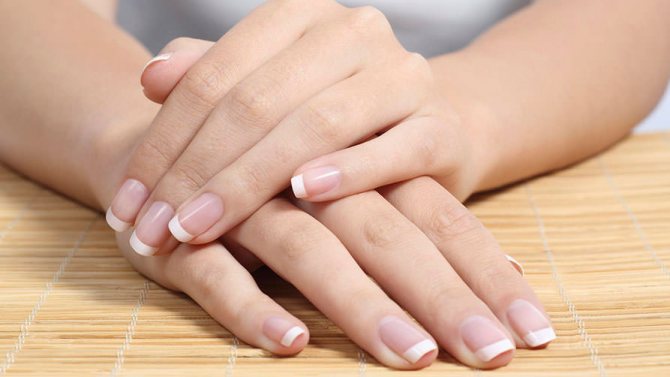

The rich composition of the plant is able to strengthen weak nails.
For a long time, healers have used the juice from the leaves of the plant to stop bleeding, accelerate tissue regeneration and relieve pain. The active substances contained in the Kalanchoe strengthen the teeth and nail plates. Healers used to brew decoctions from the leaves and inflorescences of the plant to maintain youth, give strength and relieve depression. The magic decoction is especially useful for the elderly who have lost their thirst for life. In modern realities, the juice of a plant can be purchased from a pharmacist in the form of an alcoholic tincture or granules, another method is to use fresh juice from plucked leaves. Healers advise using the liquid to relieve symptoms and treat the following diseases:
- tuberculosis;
- dilated veins;
- depression and apathy;
- open wounds;
- premature aging of the skin;
- unhealthy complexion;
- prostration;
- stomach ulcer;
- neurotic disorders;
- tissue burn;
- skin rashes;
- hair loss.
Signs about plant diseases
- When a plant begins to wilt or becomes sick, this serves as a hint of a serious illness of one of the household members.
A prolonged absence of flowers on it can indicate envy, anger and lack of understanding in the family.
But the explanation as the cause of Kalanchoe diseases to omens and superstitions can be questioned. The flower can dry out due to poor conditions. Perhaps it lacks sunlight, and therefore the upper leaves turn yellow and curl. If the leaves dry out from below, then there is not enough moisture. There may be other reasons: a cramped pot or banal old age, or the plant may be infected.
Possible difficulties
Rotting roots and / or outer parts.
The reasons:
- poor quality drainage.
- excess moisture in the soil.
- abundant watering in the cold season.
- increased air and soil humidity at high temperatures.
Strongly elongated stems.
Reason: lack of lighting.
Outgrowths - "plugs" on the leaves, shoots and / or stem.
The reasons:
- a sharp change in the level of soil moisture.
- temperature drops.
Poor, faded or late flowering.
The reasons:
- lack of sunlight.
- poor or too rare feeding.
- insufficient watering.
Signs and superstitions
Healing plants such as Kalanchoe emit positive energy to the person and the house in which they are located. Here's what the people say about the Kalanchoe:
- This plant harmonizes the atmosphere in the house, removes negative energy. In a family that will lead Kalanchoe houses, good relations will be established, there will be less swearing and disputes.
- It is customary to grow the flower on the windowsill of the kitchen, because the whole family gathers there, and the Kalanchoe is the keeper of the family hearth.
- Kalanchoe blooms in families with a good friendly atmosphere, if your plant has not bloomed for many years, then one of the family members is dishonest in their feelings or good intentions.
- If there is a person in your family who often gets angry or swears, put this plant in his room. It tunes a person to positive emotions, and absorbs the energies of anger and anger.
If we consider the teachings of Feng Shui, Kalanchoe refers to the element of Fire (Plants preferring well-lit rooms). May help people suffering from depression and despondency. Helps to find peace of mind. Recommended for growing up to grandparents, for removing "heaviness" from the body and soul.
Also, the teaching helps us choose a plant to our liking:
- If you want to attract money to your family, choose a type with small rounded leaves (K. Mangina).
- To fill your home with creative energy, choose species that grow upward (K. Dergemon, felt, feathery).
- To ground strong energy flows, ampelous species are used, in which shoots grow down to the ground (K. Tessa, Mangina).
- To enhance energy flows, place a plant with pointed leaves (dissected, tubular Kalanchoe) at home.
Since about the seventies of the last century, the Kalanchoe flower began to appear more and more on the windows of apartments. Not that this flower was not known, but in the seventies there was a significant breakthrough in the breeding of this plant, which significantly enriched the range of sold indoor plants.
It is the perfect flower for the home. It blooms beautifully, withstands a dry and warm home climate and does not require any special care.
The history of this flower begins in the 19th century, when this plant was first described. In the period between the world wars, the botanist Pierre de la Battier declared a plant in Madagascar at an altitude of about 2 km above sea level, which formed the basis for his commercial cultivation of this flower. It was later named for the horticultural entrepreneur Robert Blossfeld, who practically cultivated the plant. Since that time, the most popular plant of this group is called Kalanchoe Blossfeld.
Breeders and gardeners from Denmark, Holland and America have contributed to the emergence of the beautiful and colorful varieties. It is believed that the worldwide production of this beautiful plant totals approximately 100 million pieces. In addition to the most popular Kalanchoe blossfeldiana, you will sometimes find on sale a very interesting type of Kalanchoe beharensis.
This species also originates from Madagascar, where it grows to a height of three meters and blooms with uniquely beautiful flowers. In addition to these two species, to decorate your home or workplace, you can purchase other varieties that are created by a complex crossing and are called only the ‘Lucky Bells’ by the name of the variety.
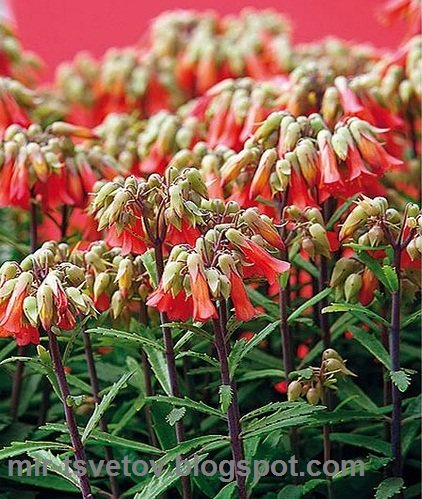

‘Lucky Bells’
Growing and care
.
Kalanchoe is perfect for warm and light interiors. This flower belongs to the genus of succulents of the Crassulaceae family, which also includes a number of succulent plants. These plants tolerate long-term dry well, but this of course does not mean that they do not need to be watered. The amount of watering depends on the season. During vegetative growth and in the season of long daylight hours, the plant should be watered so that the ground dries out a little between waterings.
Abundant watering for Kalanchoe is harmful, there is a high risk of the onset and spread of fungal diseases, as well as a decrease in immunity. During this period, the plant must be fertilized, for example, with a weak fertilizer solution every two to three days. With the onset of winter and a decrease in the intensity of the available light and a shorter day, the watering intervals should be increased or at least decreased the amount of water to irrigate. At this time, stop fertilizing and try to provide as much light as possible.
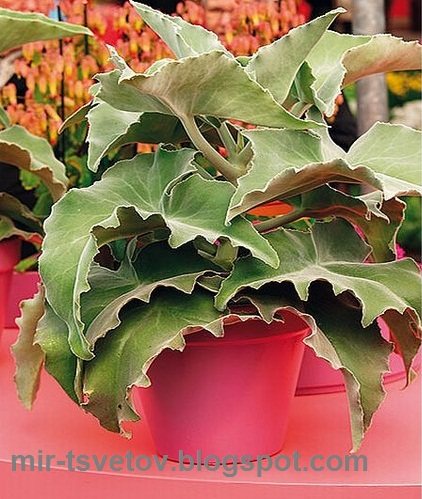

Sometimes it happens that the plant is attacked by aphids or mealybugs. In this case, you need to remove the pests as quickly as possible with the help of products to combat these insects, which you can buy in the store.In summer, Kalanchoe can be taken out into the open air, therefore, it is better to treat plants against pests outside. If the plant is badly damaged, it is better to destroy it so as not to infect other flowers that are still healthy. Sometimes Kalanchoe gets sick with viral diseases.
Most often they are spread by the insects themselves, so it is important to act quickly in the event of an attack. Viral diseases manifest themselves in such a way that round spots appear on the leaves, or the so-called mosaic, when yellow and green shades alternate. A plant damaged by viruses stops growing and weakens. In this case, the best solution is to get rid of the diseased plant and purchase a new one.
Subscribe to update the news of the site "World of Flowers"
You don't have to be a florist to grow flowers at home. Many plants are quite easy to care for and do not require much time and effort.
One of which colors is Kalanchoe. This flower pleases its owners not only with its external beauty, but also with its healing abilities.
Flower meaning
The plant symbolizes peace of mind, harmony and concentration. Sorcerers and witches prepared protective infusions with the sap of the plant, and healers used it for medicinal purposes. The flower absorbs the frustration and pain of a person, bestows happiness and prosperity.
Kalanchoe is a talisman against troubles, evil and magical effects. Resists damage, love spell, slander. But a home flower is not able to resist poisonous infusions cooked from another plant of the same kind. If a charmed Kalanchoe appears in the house, the second will not be able to absorb the negative impact.
According to signs, you cannot give this flower to a family where a wedding has recently died down or a baby has been born.
This can harm the newlyweds or the baby, bring misfortune. But for a family with an older child, such a plant will come in handy.
Why Kalanchoe blooms
This is considered a favorable omen, portends positive changes, the beginning of a bright streak in life.
A flowering plant has stronger magical properties, so they try to prolong flowering as long as possible, as well as provoke it after hours.
It is recommended to spend time near the blossoming Kalanchoe inflorescences as long as possible in order to:
- calm down;
- get rid of the negativity of strangers;
- solve a difficult problem;
- recharge with vivacity;
- get rid of insomnia.
Signs about the energy of Kalanchoe
It is believed that the plant itself does not spread negative energy, but is able to absorb and feel it.
This is reflected in his condition and appearance.
- The best habitat for Kalanchoe cuisine. It is there that all family members are most often present, and the plant affects none of them with its positive energy.
When someone from the family gets sick, a pot of Kalanchoe is placed at the head of his bed, contributing to a speedy recovery.
Kalanchoe, according to folk signs, can have a pacifying effect on a person. The mood will improve, it is enough to sit next to a pot of Kalanchoe for a while.
There is a belief about the Kalanchoe that a family that has such a flower at home is much less likely to get sick, and in case of illness, it recovers sooner.
It is quite possible that this is due to the folk omen of the strong good energy of the plant. But it is possible that there is a healing effect of the flower.
Content
- 1. Description 1.1. Popular varieties and varieties
The genus Kalanchoe belongs to the Crassulaceae family. It includes 73 species of annual and perennial herbaceous succulents, dwarf shrubs, epiphytes and lianas.
Translated from the Chinese language, the name of the genus means "falling and growing."This name was given for the ability to live birth: daughter plants Kalanchoe pinnata (Kalanchoe pinnata), Degremon (Kalanchoe daigremontiana) and serrated (Kalanchoe serrata) are formed on maternal plants.
The birthplace of Kalanchoe, according to various versions, is Madagascar or China. Its species grow in the tropics of Southeast Asia, Australia, South America and Africa. Cultivated Kalanchoe is grown as decorative leafy, medicinal and flowering houseplants.
First steps after purchase
Before being placed in a flower collection, the purchased Kalanchoe should be inspected to identify damage by ticks, harmful insects and pathogens. Instances infected with them should be treated immediately.
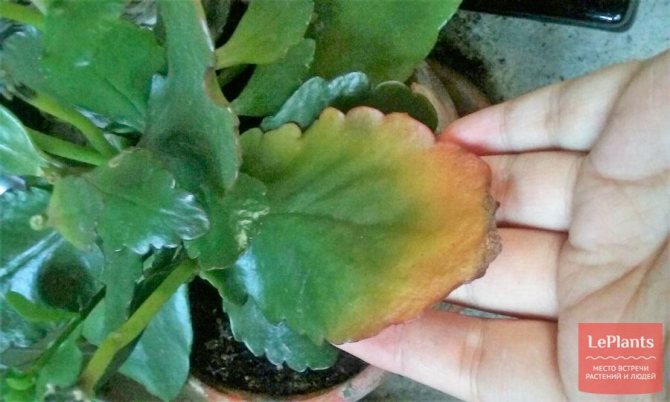

ON THE PICTURE: Such a plant should not be immediately put into a home collection. Yellowing, browning, or drying of leaves can be caused by a dangerous bacterial infection.
It is recommended to quarantine for several days, prophylactic treatment of the plant with Fitoverm insecticide and Fitosporin-M fungicide.
Warning signs
For a long time, people have noticed many signs that can warn of the negative impact of the Kalanchoe on the owner of the house and his relatives. Many of these signs and superstitions have survived to this day.
- The dying off of a significant number of the lower petals of a flower is a harbinger of a quarrel with loved ones. A person will not be able to maintain neutrality when talking about a topic of interest to him. Disagreements will lead to a protracted conflict, which can only be resolved with the help of outsiders' interference in the lives of relatives.
- As the beliefs say, the drying up of all Kalanchoe flowers is a sign indicating a withdrawal from the stormy life. A person will not be able to evenly distribute time between leisure and professional duties, which will have to sacrifice interests. Thanks to such actions, new opportunities will appear, the chance will increase to improve their financial position and status in society. However, relationships with friends will deteriorate significantly.
- According to signs, if the Kalanchoe begins to rot, then the owner of the house will be betrayed. A close friend will step over a long-term friendship for his own benefit. Everything that previously connected friends will cease to be significant, and attempts to continue communication will not be accepted from either side.
- The death of the Kalanchoe for unknown reasons is a harbinger of a fateful meeting. A person will get to know someone who will have more opportunities. A trusting relationship with a new friend will lead to the exchange of important information. After that, the acquaintance will disappear, and after a while he will use the information received against the person himself.
Is it possible to plant Kalanchoe outdoors in summer?
If you have the opportunity, then you can drop your house friend in the open ground for the summer season. To do this, it is imperative to prepare the plant for bright sunlight, in order to avoid leaf burns. Also, if night temperatures are below +13 degrees, the plant may freeze out of habit.
In order to accustom the Kalanchoe to the street, you need to start taking it out in the daytime (avoiding direct sunlight). First, a few days for one hour, then a couple of days for two to three hours, thus increasing the time of stay by an hour every day. When your plant is outdoors all day, leave it overnight. After 3-4 nights it will be possible to plant in open ground. Usually, small flower beds or garden pots are used to plant Kalanchoe in the garden.
If your area has very hot summers, it is recommended to shade the plant during the sun hours. And don't forget about watering. Make sure to return the plant home in time. It is best to do this in late summer - early September, when night temperatures have not yet begun to drop below +13 degrees.
It is not necessary to transplant the plant into open soil.To prevent plant stress and pest infestation, you can simply bring the pot of Kalanchoe to your garden plot.
What is a plant
Kalanchoe was brought from Madagascar and has more than 200 species in its diversity.
Some plants have not only the ability to provide energy benefits, but also to exercise medicinal properties.
The plant is characterized by a rich palette of shades, a variety of colors of buds not large in size and original large fleshy leaves, elastic in their texture and having an oval shape with jagged edges. Kalanchoe looks no higher than 30 cm. Inflorescences consist of small flowers.
Plant care
Despite the simplicity of caring for the Kalanchoe, it is necessary to adhere to certain rules:
- Watering is observed according to the season. For the summer period, water the plant once a week.
In winter, the frequency of watering is once every 2 weeks.
When watering is carried out in the summer, it is necessary to use settled water, which is about a day in the room.
Watering with cold tap water is strictly prohibited.
It is necessary to ensure that water drops do not remain on the stem of the plant, this can lead to the development of diseases.
If excessive watering is detected and water is found in the pot above ground level or in a sump, it must be removed. This is due to the fact that the Kalanchoe is native to the tropics and is highly drought tolerant.
In winter, compliance with these rules is also necessary, but special care is required so that water does not accumulate on the leaves, to prevent water ingress, the leaves must be lifted when watering. The water temperature cannot be lower than room temperature.
Kalanchoe is very fond of light, which contributes to its flowering. But the amount of light exposure cannot be more than 10 hours. In addition, fertilizing is also necessary, which is applied once a month, which also affects the flowering frequency.
Positive signs
This flower is a rather favorable plant that affects both the person himself and family relationships.
1. It was noticed that in families with Kalanchoe, peace and harmony flourish, household members quarrel and conflict less, mutual understanding reigns, their ability to seek compromises and negotiate has increased.
2. The ability of a flower is the mood of any conflicted person for benevolence and openness. Such people begin to look at life optimistically, open up from the good side and do not close for communication.
3. Kalanchoe is credited with the ability to absorb negativity and purify the room in which it grows.
4. The flowering of a plant is a positive phenomenon, since it characterizes a family in which it grows harmonious, peaceful and able to get along with each other. In such a family, love flourishes. Frequent flowering indicates that these households are really friendly.
Negative omens
For this plant, there are no frightening signs and no superstitions. The Kalanchoe is characterized by negative aspects associated with a change in its color or deterioration of health.
- If the plant, for no reason, suddenly began to disappear, it symbolizes that the Kalanchoe took the negative blow intended for the owners of the house. Perhaps family members suffered damage that the plant took over.
The plant does not bloom for a long time. According to signs, the refusal to bloom can be triggered by the fact that there is no friendship, love, understanding and peace in the family.
How to choose a Kalanchoe for home
Kalanchoe can store water and go without watering for a long time. According to the principles of Feng Shui, this property is considered a symbol of well-being, poise and stability. When purchasing a Kalanchoe indoor plant for your home, you need to decide where it will stand and think about its effect on the indoor environment.
- To attract money, it is worth choosing Kalanchoe varieties with small rounded leaves resembling coins, for example, Kalanchoe Mangina.
- To fill the room with creative, creative energy, plants that stretch upwards are suitable. This Kalanchoe Degremona, feathery or felt Kalanchoe.
- To soften stress and avoid conflict situations, it is better to buy a flower with succulent rounded leaves. An ordinary Kalanchoe (Blossfeld) is suitable for this,
- Dropped leaves, curling or drooping stems ground energy: can be used to muffle overly powerful currents. Kalanchoe "Tessa" and Mangina will be useful.
- To enhance energy flows, flowers with sharp leaves can be placed in a weak sector: tubular Kalanchoe, "deer horns" or felt Kalanchoe.
If the Kalanchoe bloomed
It's good when flowering begins. Many signs depend on the location of the bush:
- It blooms on the windowsill, which means that there will be happiness in the house, an event will occur that will leave many pleasant memories.
- Blossoms in the kitchen - there will be prosperity. This means that a person, an apartment owner, needs to move up the career ladder.
- The color in the room of the newlyweds indicates an addition to the family.
- Near the place where the pregnant woman is, means a quick birth without any complications and the birth of a healthy baby.
- In the baby's room, such a plant will be appropriate, because the child will have a great future and success in professional activities.
- Near the patient - to a speedy recovery and help from doctors.
- In the hallway, guests will soon arrive who will change their usual way of life.
- On the desktop, it symbolizes the chosen path of life and field of activity.
Where to settle Kalanchoe
Kalanchoe has Madagascar roots, being a hybrid of the island's wild plants. Perhaps that is why it contains many unique elements, and it is often used for medicinal, prophylactic purposes, and is grown to create a favorable atmosphere in the house.
One of the common beliefs says that this plant is capable of absorbing the negative energy of everyone who lives in the house, and tune in to a kind and positive mood. But for this to happen, you need to know some of the nuances of its cultivation.
This indoor bush is unpretentious, it does not require long and painstaking grooming. It is enough to keep its triangular, jagged leaves clean, water it moderately, and transplant it once a year into fresh soil with top dressing for the soil.
Our ancestors believed that it was such a plant that could empower, cleanse from evil thoughts and direct a person's energy in the right direction. It had its own effect on every household member, providing one hundred percent help.
Surprisingly, not one of the signs does not portend a negative interpretation. And this is true, because such a magical bush that cures ailments cannot simultaneously attract evil spirits, stirring up the other world.
In order for Kalanchoe to have the most favorable effect on the whole family, the pot should be placed in the room where you often gather together to discuss pressing matters over a cup of coffee or a plate of soup. Most often, such a place is.
Do not forget that this type of houseplants in the philosophy of Feng Shui is referred to the element of fire. It loves the sun and light very much. It is better to place it on the south-facing windows. According to legend, the more the leaves are saturated with sunlight, the more they will absorb the negative, clearing the space around for a stream of joy and abundance.
Being a meter away from you, this bush is able to change the mood, make the atmosphere favorable for fruitful communication. But for this you need to be partial to the flower, water, notice and praise its flowering, it must feel that you need it. Our great-grandmothers believed in this and passed on the omen to us.
Signs for improving health and increasing efficiency
This Madagascar miracle should be created for those who often have irregular working hours, who are overworked, are prone to stressful situations, have a weak energy field, and find themselves in situations that worsen their psycho-emotional state.
Kalanchoe, grown in an apartment, restores strength lost during a hard and long working day, returns a person to an adequate perception of the surrounding space and what is happening in it, protects the owner's health from potential energy vampires.
The working spirit will last if this magic bush is presented to your office. He can also easily identify those who come to your office with insidious plans and are not interested in your success and prosperity. To do this, you just need to watch the flower: suddenly it began to wither and wither - you urgently need to consider options for protecting your business from competitors.
One of the superstitions of our ancestors says that this plant can easily diagnose the situation in the house, the state of mind of the household. If there is no flowering and the bush is withering away, then the family needs help. Kalanchoe desperately absorbs all the ailments, problems and sorrows of the residents, but not coping with this, he can easily die.
The bright, lush flowers and lush green leaves of Kalanchoe, on the other hand, are a sign of stability and well-being. By releasing beneficial substances, the air in the room becomes fresher, cleaner and free of microbes.
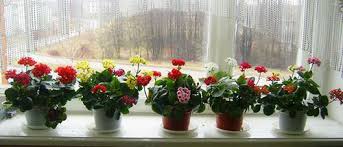

Superstitious people believe that this plant is able to get rid of a cold in case of a cold, quickly heal bleeding wounds, cleanse the blood and remove various toxins and toxins from the body. To do this, you need to use freshly squeezed juice of the stem and flower petals.
Superstitions for women
Kalanchoe energy especially helps the fair sex. In the old days, it was believed that the plant helps unmarried women meet their love, get married, and married women - to improve relationships, refresh their feelings. Culture can be the guardian of the family hearth, protect against betrayal, interference of parents, other relatives and strangers in the relationship between spouses.
A flowering bush foreshadows a bright streak in life for a woman, helps to fulfill her plans and fulfill her old dream. It is also recommended to pay attention to the condition of the indoor flower.
The fast-growing and developing Kalanchoe, regularly blooming every year, is a donor of positive energy and a strong protector. With a sudden loss of decorativeness or an unexplained illness, you should think about the presence of ill-wishers in the environment.
Signs for happiness - how a flower protects a family
It is believed that this magical flower filters the air, ridding subtle matter of negative particles. By placing the plant in the children's room, you will strengthen their immunity, adding vigor, activity and fortitude to them. It is noticed that babies wake up faster, rejoicing in a wonderful morning and a new day. And in the evening they fall asleep easily, shrouded in a slightly noticeable scent of Kalanchoe.
For schoolchildren and students, the flower promises to improve academic performance, as they become more assiduous and focused in their studies. In this case, all thoughts and actions will be directed towards positive creation around.
Even in the days of paganism, healers treated people with drugs prepared from Kalanchoe. Elderly people believed that infusions prolong their life, relieve them of excessive fatigue, weakness and melancholy, which is characteristic of old people.
A long blooming Kalanchoe is a happy omen - this means that happiness and prosperity will settle in the house, and loved ones will appreciate every moment spent together in love and care for each other.
According to Chinese philosophy, Kalanchoe will bring streams of wealth and abundance if placed in the far left corner of the room, where it will not be immediately noticeable. This modest, unpretentious plant does not like the fuss around it.It is able to give material prosperity to those who do not make this the main and only goal of their existence.
In ancient times, the Kalanchoe flower was brought as a surprise at Christmas. They believed that the more you wish for good at the moment of presenting a gift, the faster you yourself will find happiness and prosperity.
Guess today with the help of the Tarot layout "Card of the Day"!
For correct fortune-telling: focus on the subconscious and do not think about anything for at least 1-2 minutes.When you're ready, draw a card:
You don't have to be a florist to grow flowers at home. Many plants are quite easy to care for and do not require much time and effort.
One of which colors is Kalanchoe. This flower pleases its owners not only with its external beauty, but also with its healing abilities.
Application in magic
Practitioners warn that the dead Kalanchoe indicates a strong damage or curse sent to the owner. The plant has absorbed the negative, but in order to protect the home, you should immediately purchase a new one.


If the flower is placed in the child's room, then he will have no problems with sleep and morning rise.
Practitioners often use the flower to track the accumulation of negativity in the home. At the first signs of wilting, it is recommended to clean with salt or wax, and also put protection from ill-wishers and envious people. Meditation next to a magic plant will quickly help you relax and relieve negativity, the procedure will be especially useful after the magic ceremony. The magical Kalanchoe placed in the nursery will strengthen their health, add strength and energy. Children will also wake up more easily in the morning and go to school without quarrels, and fall asleep more easily in the evenings. The aroma of Kalanchoe will have a beneficial effect on the ability to concentrate and memorize large blocks of information.
If the practitioner often has to deal with scandalous, aggressive or envious people, then he should constantly wear a flower in his pocket or in a bag made of natural fabric. Such a magical amulet will also protect against energy vampires. To identify ill-wishers, envious people and potential partners who should not be contacted, it is recommended to put the flower in the office. If the Kalanchoe shrinks, drops leaves or inflorescences when a guest appears, then there is no need to have anything to do with him. A common business will only bring losses and unnecessary worries.
When Kalanchoe can be harmful
As for the fact can this plant harm our health?
Then, this can only happen when we do not properly use its healing properties. So, for example, if in the spring you suddenly have a rash on the skin, a runny nose, redness of the eyes and other characteristic symptoms for flowering plants, you should not try to cure such a runny nose by instilling Kalanchoe juice in your nose.
Well, delicious and nutritious salads with the addition of the leaves of this plant against the background of dairy products can cause stomach upset. Therefore, it is recommended to eat them either as independent dishes separately from others, or together with.
As we said at the very beginning of our publication, Kalanchoe was called a "green surgeon", but you shouldn't "help" him and open up abscesses or wounds on your own. By doing this, you will only worsen your condition and can provoke damage to neighboring healthy skin areas or even infection.
Also, if you have a chronic disease, it is unreasonable to expect that the Kalanchoe will instantly heal you from it.
Kalanchoe is a fairly popular flower. It is often presented in flower pots. It looks very presentable. Signs and superstitions about Kalanchoe can tell about the magical properties of this plant.
Kalanchoe can be found in many flower lovers
Success secrets
For the complete assimilation of nutrients, Kalanchoe is fed simultaneously with watering.
The composition of the soil mixture for mature Kalanchoe differs from the substrate for a young one. Optimal soil for an "aging" succulent: sand, leafy earth and black soil in a ratio of 0.5: 1: 2.
The plant is replanted in the spring, after flowering ends. Formative pruning of the stems is done at the same time.
Beautifully flowering branchy species are pinched after the formation of the third pair of leaves. The pinching of the tops of Kalanchoe Degremon and Kalanchoe pinnate is performed at a height of 30-40 cm.
For early flowering Kalanchoe in the warm season, daylight hours are reduced to twelve hours. In order for Kalanchoe to bloom again, a dormant period of six to eight weeks is maintained with scant watering, eight hour daylight hours and cool content. At the end of the "rest", the plant is watered abundantly and placed in a bright place.

